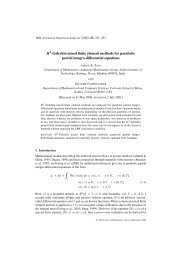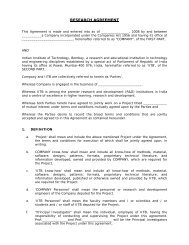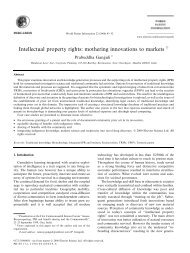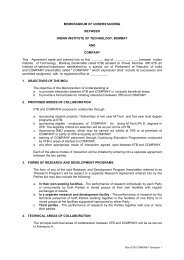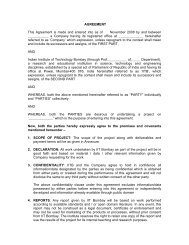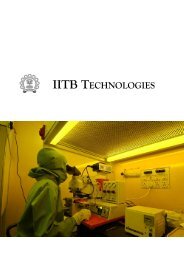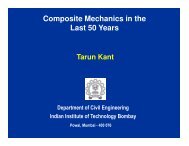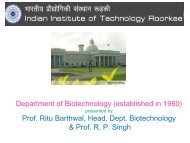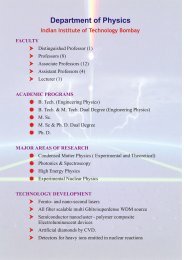Transition Metal Catalyzed [2+2+2] Cycloaddition and Application in ...
Transition Metal Catalyzed [2+2+2] Cycloaddition and Application in ...
Transition Metal Catalyzed [2+2+2] Cycloaddition and Application in ...
You also want an ePaper? Increase the reach of your titles
YUMPU automatically turns print PDFs into web optimized ePapers that Google loves.
MICROREVIEW<br />
<strong>Transition</strong> <strong>Metal</strong> <strong>Catalyzed</strong> [<strong>2+2+2</strong>] <strong>Cycloaddition</strong> <strong>and</strong> <strong>Application</strong><br />
<strong>in</strong> Organic Synthesis<br />
Sambasivarao Kotha,* [a] Enugurthi Brahmachary, [a] <strong>and</strong> Kakali Lahiri [a]<br />
Keywords: Cyclotrimerization / Heterocycles / Polycycles / Stra<strong>in</strong>ed molecules / <strong>Transition</strong> metals<br />
The [<strong>2+2+2</strong>] cycloaddition strategy is complementary to the<br />
well known Diels–Alder reaction for the generation of polycyclic<br />
compounds. This [<strong>2+2+2</strong>] approach is atom-economical<br />
<strong>and</strong>, with the availability of new catalysts to effect the<br />
[<strong>2+2+2</strong>] cycloaddition reaction, synthesis of a wide variety of<br />
highly functionalized polycycles is possible. This review deals<br />
with some recent advances relat<strong>in</strong>g to [<strong>2+2+2</strong>] cycloaddition<br />
reactions <strong>in</strong>volv<strong>in</strong>g the syntheses both of polycycles<br />
<strong>and</strong> of heterocycles. More specifically, syntheses of various<br />
biologically active molecules, unusual am<strong>in</strong>o acids, <strong>and</strong> theoretically<br />
<strong>in</strong>terest<strong>in</strong>g molecules are described. An attempt has<br />
also been made to give an overview of recent advances <strong>in</strong><br />
the achievement of chemo-, regio-, <strong>and</strong> stereoselectivity <strong>in</strong><br />
cyclotrimerization reactions.<br />
(© Wiley-VCH Verlag GmbH & Co. KGaA, 69451 We<strong>in</strong>heim,<br />
Germany, 2005)<br />
1. Introduction<br />
The development of novel reactions, useful reagents, <strong>and</strong><br />
efficient catalysts to enable the formation of carbon-carbon<br />
bonds is an important activity <strong>in</strong> organic chemistry. More<br />
specifically, the use of carbon-carbon bond formation reactions<br />
to generate new r<strong>in</strong>g systems is a key part of contemporary<br />
organic synthesis. In this respect, cycloaddition reactions<br />
are considered to be strategically useful where more<br />
than one carbon-carbon or carbon-heteroatom bonds are<br />
formed. With this as a goal, several researchers have developed<br />
new reaction pathways aimed towards the synthesis of<br />
complex organic molecules with cycloaddition reactions as<br />
key steps. Novel catalysts <strong>and</strong> new reaction conditions address<strong>in</strong>g<br />
the chemo- <strong>and</strong> regioselectivity aspects of these cycloaddition<br />
reactions have been discovered.<br />
Strategically, [<strong>2+2+2</strong>] cycloaddition <strong>in</strong>volv<strong>in</strong>g alkynes to<br />
generate annulated benzene derivatives is one of the more<br />
elegant methods for the construction of polycyclic aromatics.<br />
S<strong>in</strong>ce the discovery of benzene formation by thermal<br />
cyclization of three acetylene molecules by Bertholet <strong>in</strong><br />
1866, several advances have appeared <strong>in</strong> the literature. More<br />
specifically, the transition metal catalyzed cyclotrimeri-<br />
[a] Department of Chemistry, Indian Institute of Technology Bombay,<br />
Powai, Mumbai 400 076, India<br />
Fax: +91-22-2572.3480<br />
E-mail: srk@chem.iitb.ac.<strong>in</strong><br />
zation of acetylenes to benzene derivatives reported by<br />
Reppe et al. <strong>in</strong> 1948 [1a] accelerated the utility of metal catalysts<br />
<strong>in</strong> this area. S<strong>in</strong>ce then, various transition metal catalysts<br />
based on Ni, Co, Pd, Cr, Rh, Fe, Zr, Nb, Ir, <strong>and</strong> Ta<br />
have been developed for the trimerization reaction <strong>in</strong>volv<strong>in</strong>g<br />
alkynes. Recently, Heiz <strong>and</strong> co-workers have reported that<br />
even a s<strong>in</strong>gle palladium atom supported on MgO (100)<br />
films can catalyze the production of benzene from acetylene<br />
at low temperature (300 K). [1b] In addition to alkynes, other<br />
unsaturated components such as nitriles, isocyanates, olef<strong>in</strong>s,<br />
carbonyl compounds, im<strong>in</strong>es, <strong>and</strong> diimides have been<br />
shown to participate <strong>in</strong> cyclotrimerizations with alkynes to<br />
deliver useful end products. With the development of various<br />
catalysts these applications cont<strong>in</strong>ue to grow: a significant<br />
number of reports have recently focused on the application<br />
of the alkyne trimerization reaction for the construction<br />
of new carbo- <strong>and</strong> heterocyclic frameworks useful <strong>in</strong><br />
the synthesis of natural products <strong>and</strong> complex polycyclic<br />
aromatic compounds. [2–7] This review focuses on recent aspects<br />
of cyclotrimerization reactions, <strong>and</strong> examples appear<strong>in</strong>g<br />
<strong>in</strong> previous reviews are not presented <strong>in</strong> detail, although<br />
some earlier examples are <strong>in</strong>cluded as <strong>and</strong> when necessary.<br />
The most common product of the acetylene cyclotrimerization<br />
is benzene (1; Scheme 1). Acetylene trimerization<br />
by a symmetry-allowed [<strong>2+2+2</strong>] cycloaddition reaction<br />
is an exothermic process (ΔH = –594 kJmol –1 ), but requires<br />
higher temperature or a catalyst because of entropic<br />
<strong>and</strong> k<strong>in</strong>etic considerations. If two alkynes were tethered, an-<br />
MICROREVIEWS: This feature <strong>in</strong>troduces the readers to the authors’ research through a concise overview of the<br />
selected topic. Reference to important work from others <strong>in</strong> the field is <strong>in</strong>cluded.<br />
Eur. J. Org. Chem. 2005, 4741–4767 DOI: 10.1002/ejoc.200500411 © 2005 Wiley-VCH Verlag GmbH & Co. KGaA, We<strong>in</strong>heim 4741
MICROREVIEW<br />
nulated benzene derivative 2 would be generated, whilst if<br />
all three alkynes were connected a tricyclic r<strong>in</strong>g 3 would be<br />
formed.<br />
S. Kotha, E. Brahmachary, K. Lahiri<br />
ample, yielded products regioselectively comparable to<br />
those found <strong>in</strong> organic solvents, but the utility of supercritical<br />
water as the solvent was severely limited by significant<br />
hydrolysis of nitrile derivatives <strong>in</strong> cyclizations of two alkynes<br />
<strong>and</strong> a nitrile under similar conditions.<br />
Eaton <strong>and</strong> co-workers reported the cyclization of hydrophilic<br />
alkynes <strong>in</strong> a water/methanol solvent system, [10] Butenschön<br />
et al. have recently reported cobalt-catalyzed alkyne<br />
cyclotrimerization reactions <strong>in</strong> aqueous solution<br />
(water/ethanol 80:20) at room temp. without any additional<br />
activation, [11] whilst a biphasic aqueous organic system appears<br />
to be useful for certa<strong>in</strong> cyclotrimerized products, especially<br />
for medium- or large-r<strong>in</strong>g systems (Scheme 2). [12]<br />
Scheme 1.<br />
Cyclotrimerization of suitably placed alkyne derivatives<br />
can provide otherwise difficult to prepare highly substituted<br />
aromatic compounds. For a long time the regioselectivity of<br />
the product was a primary concern for this type of reactions,<br />
[5] but little success was achieved despite enormous efforts<br />
to control regioselectivity <strong>in</strong> these types of reactions.<br />
In general, these reactions can be performed <strong>in</strong> common<br />
organic solvents at temperatures rang<strong>in</strong>g from room temp.<br />
upwards. Cobalt-catalyzed alkyne trimerizations can be performed<br />
<strong>in</strong> supercritical water [8] or <strong>in</strong> supercritical carbon<br />
dioxide: [9] co-trimerization reactions <strong>in</strong>volv<strong>in</strong>g mono-substituted<br />
alkynes <strong>in</strong> supercritical water as the solvent, for ex-<br />
Scheme 2.<br />
Sambasivarao Kotha was born <strong>in</strong> Amarthalur, Guntur District, AP, India. He received his B.Sc. degree from Nagarjuna<br />
University <strong>in</strong> 1977 <strong>and</strong> his M.Sc. degree from the University of Hyderabad <strong>in</strong> 1979. In 1985 he obta<strong>in</strong>ed his Ph.D. degree<br />
under the supervision of Professor G. Mehta at the University of Hyderabad. Subsequently, he worked with Professor<br />
R. J. Stoodley (1986–1987) at UMIST, Manchester, UK, <strong>and</strong> Professor J. M. Cook (1987–1989) at the University of<br />
Wiscons<strong>in</strong>, Milwaukee, as a research associate. Later, he jo<strong>in</strong>ed Cornell University as a visit<strong>in</strong>g scientist <strong>and</strong> worked <strong>in</strong><br />
Professor A. Kuki’s group on AIB peptide synthesis. In 1992–1993 he worked at Hoechst Celanese, Corpus Christi, Texas,<br />
as a research chemist. In 1994 he jo<strong>in</strong>ed IIT Bombay as an Assistant Professor <strong>and</strong> was promoted to Professor <strong>in</strong> 2001.<br />
He was a recipient of the B. M Birla prize <strong>in</strong> Chemical Sciences (1996), the Professor N. S. Narasimhan endowment<br />
award (2000), <strong>and</strong> the CRSI bronze medal (2004). He has been elected as a member of the editorial board of the Indian<br />
Journal of Chemistry. His current research <strong>in</strong>terests <strong>in</strong>clude methods <strong>in</strong> organic synthesis, unusual am<strong>in</strong>o acids, peptide<br />
modifications, Suzuki coupl<strong>in</strong>g, metathesis, <strong>and</strong> theoretically <strong>in</strong>terest<strong>in</strong>g molecules.<br />
Enugurthi Brahmachary was born <strong>in</strong> Aloor, Andhra Pradesh <strong>in</strong> India. After his early education <strong>in</strong> Aloor <strong>and</strong> Nirmal he<br />
obta<strong>in</strong>ed a B.Sc. degree from Kakatiya University <strong>in</strong> 1992, followed by a M.Sc. degree from Osmania University <strong>in</strong> 1994.<br />
He then moved to the Indian Institute of Technology-Bombay to pursue graduate study, receiv<strong>in</strong>g his Ph.D. degree <strong>in</strong><br />
Organic Chemistry <strong>in</strong> 2000 under the direction of Prof. Sambasivarao Kotha for research that focused on development of<br />
new methodologies for the synthesis of unnatural am<strong>in</strong>o acids. After his graduation he jo<strong>in</strong>ed Prof. J. M. J. Fréchet’s<br />
research group at the Department of Chemistry, University of California, Berkeley, as a postdoctoral fellow. At Berkeley,<br />
his research focused on comb<strong>in</strong>atorial approaches for chiral recognition <strong>and</strong> preparation of new polymeric materials for<br />
the resolution of racemic compounds. He is currently a research scientist at the Medic<strong>in</strong>al Chemistry division at Chem-<br />
Bridge Research Laboratories <strong>in</strong> San Diego. California. His current research <strong>in</strong>terests <strong>in</strong>clude chemistry <strong>and</strong> biology of<br />
am<strong>in</strong>o acids <strong>and</strong> peptides, comb<strong>in</strong>atorial chemistry, <strong>and</strong> medic<strong>in</strong>al chemistry.<br />
Kakali Lahiri (née Chakraborty) was born <strong>in</strong> Hooghly, West Bengal. She obta<strong>in</strong>ed her B.Sc. degree <strong>in</strong> chemistry from<br />
Burdwan University, West Bengal <strong>in</strong> 1993 <strong>and</strong> her M.Sc. degree <strong>in</strong> organic chemistry from Burdwan University <strong>in</strong> December<br />
1995. In 2002 she obta<strong>in</strong>ed her Ph.D. degree under the guidance of Professor S. Kotha from the Department of<br />
Chemistry, Indian Institute of Technology Bombay. Presently she is work<strong>in</strong>g as a Research Associate <strong>in</strong> the Department<br />
of Chemistry, Indian Institute of Technology Bombay. Her research <strong>in</strong>terests are the development of new methodologies<br />
for the synthesis of <strong>in</strong>terest<strong>in</strong>g molecular frameworks <strong>and</strong> the modification of peptides.<br />
4742<br />
© 2005 Wiley-VCH Verlag GmbH & Co. KGaA, We<strong>in</strong>heim www.eurjoc.org Eur. J. Org. Chem. 2005, 4741–4767
<strong>Transition</strong> <strong>Metal</strong> <strong>Catalyzed</strong> [<strong>2+2+2</strong>] <strong>Cycloaddition</strong>s<br />
2. Intermolecular [<strong>2+2+2</strong>] <strong>Cycloaddition</strong>:<br />
Cyclotrimerization of Alkynes<br />
Both homogeneous <strong>and</strong> heterogeneous catalyst systems<br />
have been used for cyclotrimerization of alkynes. New catalysts<br />
generally appear to be comb<strong>in</strong>ations of known <strong>and</strong><br />
unknown metal complexes: an activated zirconium-titanium<br />
mixture, for example, has been found to catalyze alkyne trimerization<br />
<strong>in</strong> good yields. [13a] This highly reactive metal catalyst<br />
was prepared by reduction of zirconium(iv) chloride<br />
<strong>and</strong> titanium(iii) chloride with lithium powder <strong>in</strong> a dry dimethoxyethane/tetrahydrofuran<br />
mixture, alkyne was added<br />
directly to the reaction mixture conta<strong>in</strong><strong>in</strong>g the metal complex,<br />
<strong>and</strong> the product was isolated by simple filtration. Both<br />
term<strong>in</strong>al <strong>and</strong> <strong>in</strong>ternal alkynes have been cyclotrimerized,<br />
but no significant regioselectivity was observed. Takahashi<br />
<strong>and</strong> co-workers have recently used zirconacyclopentadienes<br />
as attractive <strong>in</strong>termediates for the synthesis of six-membered<br />
heterocycles, with zirconacyclopentadienes prepared<br />
<strong>in</strong> situ from Cp 2 ZrEt 2 <strong>and</strong> two symmetrical or unsymmetrical<br />
alkynes or diynes react<strong>in</strong>g with C=O, C=N, <strong>and</strong> N=N<br />
moieties conta<strong>in</strong><strong>in</strong>g electron-withdraw<strong>in</strong>g groups to give pyran,<br />
pyrid<strong>in</strong>e, <strong>and</strong> dihydropyridaz<strong>in</strong>e derivatives, respectively,<br />
<strong>in</strong> good yields. [13b] For the synthesis of pyran <strong>and</strong><br />
dihydropyridaz<strong>in</strong>e derivatives the presence of a metal salt<br />
such as BiCl 3 or CuCl is essential. The same strategy was<br />
used for selective preparation of pyridones <strong>and</strong> im<strong>in</strong>opyrid<strong>in</strong>es<br />
from two different alkynes via azazirconacycles, [13c]<br />
whilst a low-valent tantalum system derived from TaCl 5<br />
<strong>and</strong> Zn has also been reported for this purpose. [14] Notably,<br />
the reactivity <strong>and</strong> the yields are found to depend ma<strong>in</strong>ly on<br />
the solvent system <strong>and</strong> the substituents on the alkyne. Ishii<br />
<strong>and</strong> co-workers reported cyclotrimerization of alkynes (e.g.,<br />
7) with use of a multi-catalytic system <strong>in</strong>volv<strong>in</strong>g Pd(OAc) 2 ,<br />
chlorohydroqu<strong>in</strong>one (HQ-Cl), <strong>and</strong> molybdovanadophosphate<br />
(NPMoV) <strong>in</strong> the presence of dioxygen (Scheme 3). [15]<br />
No products were formed without an oxygen source, <strong>and</strong><br />
temperature above 60 °C were necessary for the success of<br />
the reaction. Interest<strong>in</strong>gly, some <strong>in</strong>ternal alkynes converted<br />
<strong>in</strong>to aromatized products <strong>in</strong> quantitative yields under these<br />
conditions <strong>and</strong> term<strong>in</strong>al alkynes gave exclusively 1,3,5-trisubstituted<br />
benzenes.<br />
MICROREVIEW<br />
lenes. [16] Molybdenum(0) complexes were <strong>in</strong>vestigated for<br />
the cyclotrimerization of “electron-poor” alkynes such as<br />
ethyl propiolate (9) <strong>and</strong> dimethyl acetylenedicarboxylate<br />
(DMAD) (Scheme 4). [17] Parent molybdenum carbonyl<br />
complexes under nitrogen atmosphere <strong>in</strong>duce cyclotrimerization<br />
of ethyl propiolate <strong>in</strong> good yields with about a 2:1<br />
ratio of 1,2,4- <strong>and</strong> 1,3,5-carboethoxybenzene (Scheme 4),<br />
whilst an N-methylimidazole (1-Meim) complex of molybdenum<br />
carbonyl [Mo(CO) 3 (1-Meim) 3 ] proved to be efficient<br />
for the selective formation of the 1,3,5-regioisomer as the<br />
major product. A similar selectivity has been observed for<br />
phenylacetylene <strong>and</strong> ethyl propiolate.<br />
Scheme 4.<br />
Recent efforts <strong>in</strong> this area have focused on the application<br />
of various catalysts to achieve regio- <strong>and</strong> chemoselectivity<br />
<strong>in</strong> the cyclotrimerization of alkynes. Ladipo et al. have<br />
reported the use of a calixarene-bound titanium complex to<br />
<strong>in</strong>duce 1,2,4-regioselectivity <strong>in</strong> the trimerization of term<strong>in</strong>al<br />
alkynes (Scheme 5): [18] <strong>in</strong> the presence of excess amounts of<br />
sodium <strong>and</strong> the catalyst, several mono-substituted alkynes<br />
were trimerized to give 1,2,4-substituted benzene derivatives<br />
such as 14 as the major products. Aryl- <strong>and</strong> trimethylsilylsubstituted<br />
acetylenes gave the 1,2,4-isomers regioselectively<br />
( 98%). The same group has further <strong>in</strong>vestigated the<br />
scope <strong>and</strong> mechanism of the reaction; [19] their mechanistic<br />
studies <strong>in</strong>dicated that the steric dem<strong>and</strong> of the calixarene<br />
cavity is responsible for the observed selectivity.<br />
Scheme 5.<br />
Scheme 3.<br />
Several transition metal catalysts are known to effect the<br />
cyclotrimerization reaction, but chemo- <strong>and</strong> regioselectivity<br />
appear to be serious problems, a significant number of reports<br />
hav<strong>in</strong>g focused recently on this important aspect.<br />
Phosphane complexes of Co I ,Rh I , <strong>and</strong> Ir I are generally<br />
used for the dimerization <strong>and</strong> cyclotrimerization of acety-<br />
Sato <strong>and</strong> co-workers reported a novel Reppe-type cyclotrimerization<br />
method for the preparation of aryltitanium<br />
compounds, three different unsymmetrical acetylenes <strong>and</strong><br />
one molecule of a specific metallic species be<strong>in</strong>g comb<strong>in</strong>ed<br />
together <strong>in</strong> a highly controlled manner to give aromatic organometallic<br />
compounds directly. [20] As shown <strong>in</strong> Scheme 6,<br />
a dialkoxytitanocyclopentadiene 17 was prepared from two<br />
different acetylenes (15 <strong>and</strong> 16) <strong>and</strong> a divalent titanium alk-<br />
Eur. J. Org. Chem. 2005, 4741–4767 www.eurjoc.org © 2005 Wiley-VCH Verlag GmbH & Co. KGaA, We<strong>in</strong>heim 4743
MICROREVIEW<br />
oxide reagent. Treatment of 17 with ethynyl tolyl sulfone<br />
(18) gave aryl titanium compound 19, which could be<br />
treated with various electrophiles to produce other substituted<br />
aromatic compounds such as 20.<br />
S. Kotha, E. Brahmachary, K. Lahiri<br />
cyclooctadiene) catalyst <strong>and</strong> 1,2-bis(diphenylphosphanyl)-<br />
ethane (dppe) lig<strong>and</strong>. When 1,2-bis(dipentafluorophenylphosphanyl)ethane<br />
was used, one molecule of DMAD reacted<br />
with two molecules of mono-yne to give the 1:2 coupl<strong>in</strong>g<br />
product, so selective [<strong>2+2+2</strong>] cycloadditions of two different<br />
mono-ynes can be achieved by appropriate selection<br />
of the lig<strong>and</strong>. [23]<br />
Yamamoto <strong>and</strong> co-workers have described a useful process<br />
<strong>in</strong>volv<strong>in</strong>g nickel-catalyzed regioselective cyclotrimerization<br />
of 1-perfluoroalkylenynes. [24] The (E)-perfluorohexyl-enyne<br />
derivative 24, for example, was cyclotrimerized<br />
<strong>in</strong> the presence of 10 mol-% Ni(PPh 3 ) 4 , prepared<br />
from Ni(cod) 2 <strong>and</strong> PPh 3 , to produce the 1,2,4-trisubstituted<br />
benzene derivative 25 <strong>in</strong> good yield (Scheme 8). The reaction<br />
proceeded smoothly <strong>in</strong> a highly regioselective manner,<br />
<strong>and</strong> only a trace amounts of 1,3,5-isomer were observed<br />
with most of the substrates.<br />
Scheme 6.<br />
Recently, Gevorgyan <strong>and</strong> co-workers [21] have demonstrated<br />
aryl r<strong>in</strong>g formation <strong>in</strong> a chemo- <strong>and</strong> regioselective<br />
manner through a palladium-catalyzed [<strong>2+2+2</strong>] sequential<br />
trimerization of alkynes (e.g., 21; Scheme 7). This approach<br />
has delivered both tetra- (e.g., 23) <strong>and</strong> pentasubstituted<br />
benzene derivatives <strong>in</strong> moderate yields. It was observed that<br />
the rate of the reaction could be accelerated significantly by<br />
the addition of a Lewis acid/phosphane lig<strong>and</strong> system.<br />
Jiang <strong>and</strong> co-workers reported CuCl 2 -<strong>in</strong>duced highly<br />
chemo- <strong>and</strong> regiospecific palladium-catalyzed cyclotrimerization<br />
<strong>in</strong> excellent yields. [22] Both symmetrical <strong>and</strong><br />
unsymmetrical alkynes smoothly underwent cyclotrimerization<br />
<strong>in</strong> the presence of PdCl 2 /CuCl 2 <strong>in</strong> a BuOH/benzene<br />
solvent system.<br />
Scheme 7.<br />
Takeuchi <strong>and</strong> Nakaya have observed that two molecules<br />
of DMAD react with one molecule of mono-yne to give 2:1<br />
coupl<strong>in</strong>g products <strong>in</strong> the presence of [Ir(cod)Cl] 2 (cod = 1,5-<br />
Scheme 8.<br />
Tanaka et al. used cationic rhodium(i) <strong>and</strong> modified 2,2bis(diphenylphosphanyl)-1,1-b<strong>in</strong>aphthyl<br />
(BINAP) complexes<br />
to achieve chemo- <strong>and</strong> regioselective cyclotrimerization<br />
of mono-substituted acetylenes with the electronpoor<br />
acetylene diethyl acetylenedicarboxylate (DE-<br />
ADC). [25a] The same methodology has been applied to assemble<br />
[6]metacyclophane <strong>and</strong> [7]-[12]paracyclophanes. [25b]<br />
Benzyne <strong>and</strong> other substituted benzyne derivatives undergo<br />
chemoselective cyclotrimerization either with other<br />
acetylenes or with themselves to form synthetically useful<br />
triphenylenes. Palladium catalysis has been found to be effective<br />
for such cyclotrimerization under mild reaction conditions.<br />
Fluoride ion <strong>in</strong>duces the generation of aryne 27<br />
(Scheme 9), which undergoes cyclotrimerization to give a<br />
mixture of 28a <strong>and</strong> 28b <strong>in</strong> 93:7 ratio (81% overall yield); [26]<br />
the best results were found with 10 mol-% Pd(PPh 3 ) 4 <strong>and</strong><br />
CsF <strong>in</strong> acetonitrile at room temp. They also reported cocyclization<br />
of arynes with other mono-alkynes. [27] Benzynes<br />
derived from naphthalene or phenanthrene also underwent<br />
facile cyclotrimerization to give aromatic polycyclic r<strong>in</strong>g<br />
systems. [28] Under the same reaction conditions, benzyne reacted<br />
with one or two molecules of a mono-alkyne such as<br />
DMAD to afford mixtures of phenanthrene <strong>and</strong> naphthalene<br />
derivatives <strong>in</strong> a ratio of 84:7, but when Pd 2 (dba) 3 was<br />
employed as the catalyst the naphthalene derivatives were<br />
the major products (10:83 ratio). With electron-rich alkynes,<br />
phenanthrene derivatives were generally obta<strong>in</strong>ed <strong>in</strong><br />
low yields. Yamamoto <strong>and</strong> co-workers have utilized a<br />
4744<br />
© 2005 Wiley-VCH Verlag GmbH & Co. KGaA, We<strong>in</strong>heim www.eurjoc.org Eur. J. Org. Chem. 2005, 4741–4767
<strong>Transition</strong> <strong>Metal</strong> <strong>Catalyzed</strong> [<strong>2+2+2</strong>] <strong>Cycloaddition</strong>s<br />
MICROREVIEW<br />
Scheme 9.<br />
Scheme 10.<br />
Pd(OAc) 2 /(o-Tol) 3 P catalyst system, with phenanthrene derivatives<br />
(e.g., 31) be<strong>in</strong>g obta<strong>in</strong>ed <strong>in</strong> good yields regardless<br />
of the electronic nature of the alkyne (Scheme 10). [29]<br />
Palladium-catalyzed trimerization has been applied for<br />
the synthesis of highly stra<strong>in</strong>ed decacyclenes. Compound<br />
32, for example, gave a stra<strong>in</strong>ed alkyne 33 <strong>in</strong> situ on treatment<br />
with tetrabutylammonium fluoride (TBAF) <strong>and</strong><br />
5 mol-% Pd 2 (dba) 3 (dba = dibenzylideneacetone) <strong>in</strong> acetonitrile<br />
at 60 °C (Scheme 11), <strong>and</strong> this trimerized under the<br />
same reaction conditions to deliver dodecahydrotriphenylene<br />
34 <strong>in</strong> 23% yield. [30] It was observed that generation <strong>and</strong><br />
trimerization of compound 33 with CsF <strong>and</strong> Pd(PPh 3 ) 4 <strong>in</strong><br />
CH 3 CN gave very low yields of 34. In another report,<br />
Vollhardt <strong>and</strong> co-workers synthesized tris(benzocyclobutadieno)triphenylene<br />
37 by palladium-catalyzed trimerization<br />
of didehydrobiphenylenes 36 (Scheme 12). [31a] The embedded<br />
triphenylene unit <strong>in</strong> the C 3 -symmetric trimer 37 was<br />
distorted to <strong>in</strong>crease the aromaticity of the central benzene<br />
r<strong>in</strong>g. Wegner <strong>and</strong> co-workers found that Ni 0 benzyne complexes<br />
delivered naphthalene derivatives when allowed to<br />
react with various alkynes. [31b] By the same methodology<br />
they have also prepared sulfur macrocycles, although the<br />
yield of the reaction was only moderate (45%), due to the<br />
unstable nature of the compound. [31c]<br />
Scheme 12.<br />
Scheme 11.<br />
Ikeda <strong>and</strong> co-workers have <strong>in</strong>vestigated various cyclotrimerization<br />
reactions us<strong>in</strong>g Ni(acac or cod) 2 -PPh 3 –<br />
Et 2 Zn–PhOH systems. [32] Competition of two different<br />
mono-alkynes for self-trimerization reactions was suppressed<br />
<strong>and</strong> <strong>in</strong> most cases the 1,2,4-isomer was formed with<br />
Eur. J. Org. Chem. 2005, 4741–4767 www.eurjoc.org © 2005 Wiley-VCH Verlag GmbH & Co. KGaA, We<strong>in</strong>heim 4745
MICROREVIEW<br />
S. Kotha, E. Brahmachary, K. Lahiri<br />
up to 95% regioselectivity <strong>in</strong> good isolated yields. However,<br />
three different alkynes on reaction under similar conditions<br />
gave a mixture of regioisomers along with other benzene<br />
derivatives.<br />
Sugihara et al. have reported that a methylidynetricobalt<br />
nonacarbonyl [Co 3 (CO) 9 (μ 3 -CH), 40], a known catalyst for<br />
the Pauson–Kh<strong>and</strong> reaction, also catalyzes the cyclotrimerization<br />
of mono- <strong>and</strong> disubstituted alkynes. [33] The<br />
conditions are relatively mild, <strong>and</strong> the reaction proceeded<br />
at low temperature to provide the trimerized product 39 <strong>in</strong><br />
good yields, whilst up to 67% of the catalyst could be recovered<br />
(Scheme 13). The same group also showed that the<br />
trimerization reaction shown <strong>in</strong> Scheme 3 proceeded<br />
smoothly <strong>in</strong> toluene at reflux when methylidyne complex 40<br />
was used as a catalyst (1 mol-%) to give hexa(n-propyl)-<br />
benzene <strong>in</strong> excellent yield (92%). Cyclotrimerization has<br />
also been used to prepare acetylene derivatives such as 42<br />
<strong>and</strong> 43 (Scheme 14). These compounds have been characterized<br />
as nonl<strong>in</strong>ear optical chromophores by hyper-<br />
Rayleigh scatter<strong>in</strong>g techniques. [34]<br />
Scheme 14.<br />
Scheme 13.<br />
Tagliatesta <strong>and</strong> co-workers used different rhodium porphyr<strong>in</strong><br />
catalysts for the solvent-free cyclotrimerization of<br />
arylethynes. H<strong>in</strong>dered catalysts favored the formation of<br />
less symmetrical isomers, whilst the selectivity of the reaction<br />
was also <strong>in</strong>fluenced by the nature of the substitution<br />
on the substrate. [35]<br />
1,3,5-Tris(4-nitrobenzoyl)benzene (45) was synthesized<br />
from (4-nitrobenzoyl)acetylene (44) <strong>in</strong> good yield<br />
(Scheme 15). The C 3 -symmetric compound 45 was found to<br />
form 1:1 crystall<strong>in</strong>e <strong>in</strong>clusion complexes with CH 2 Cl 2 <strong>and</strong><br />
DMSO, as <strong>in</strong>dicated by X-ray crystallographic studies. [36]<br />
Bis(1,3,5-triaroyl)benzene derivatives were prepared by an<br />
<strong>in</strong>direct route through condensation of l<strong>in</strong>ked bis(enam<strong>in</strong>ones)<br />
with aryl ethynyl ketones, s<strong>in</strong>ce the direct cyclotrimerization<br />
of l<strong>in</strong>ked aryl ethynyl ketones gave poor yields<br />
of the desired product. [37]<br />
By a similar approach, a metal-free catalytic method for<br />
the preparation of optically pure 1,3,5-tris(1,1-b<strong>in</strong>aphthyl)-<br />
benzene derivatives through an am<strong>in</strong>e-catalyzed alkyne trimerization<br />
has also been developed. [38,39] The cyclotrimerization<br />
proceeds smoothly <strong>in</strong> 54% yield <strong>and</strong> with complete<br />
regioselectivity. The reaction proceeds without epimerization<br />
of the start<strong>in</strong>g chiral b<strong>in</strong>aphthyl framework.<br />
Scheme 15.<br />
Use of another metal ion-free catalyst for cyclotrimerization<br />
of acetylenes has recently been reported. Si 2 Cl 6 -catalyzed<br />
cyclotrimerization of acetylene <strong>and</strong> other mono- <strong>and</strong><br />
disubstituted acetylenes at elevated temperatures gave good<br />
yields <strong>and</strong> was claimed to be the first reported example of<br />
cyclotrimerization operat<strong>in</strong>g by a free-radical mechanism.<br />
No regioselectivity was observed with unsymmetrical alkynes.<br />
[40]<br />
4746<br />
© 2005 Wiley-VCH Verlag GmbH & Co. KGaA, We<strong>in</strong>heim www.eurjoc.org Eur. J. Org. Chem. 2005, 4741–4767
<strong>Transition</strong> <strong>Metal</strong> <strong>Catalyzed</strong> [<strong>2+2+2</strong>] <strong>Cycloaddition</strong>s<br />
Roy <strong>and</strong> Das prepared a multivalent carbohydrate derivative<br />
by a Grubbs’ ruthenium-catalyzed cyclotrimerization<br />
of term<strong>in</strong>al alkyne 46 (Scheme 16). [41] Interest<strong>in</strong>gly, treatment<br />
of 46 with Grubbs’ catalyst <strong>in</strong> dichloromethane at<br />
room temp. gave the desired trisubstituted derivatives (47<br />
<strong>and</strong> 48), favor<strong>in</strong>g the 1,2,4-isomer 47 as the major product.<br />
A similar result was observed when dicobalt octacarbonyl<br />
was used <strong>in</strong>stead of the Grubbs’ catalyst. [42] Deacetylation<br />
of 47 <strong>and</strong> 48 afforded water-soluble trimannosides that were<br />
shown to have prote<strong>in</strong> cross-l<strong>in</strong>ker abilities. The same<br />
authors also prepared the hexamer 50 from a symmetrical<br />
<strong>in</strong>ternal alkyne 49 <strong>in</strong> good yield by a similar methodology<br />
(Scheme 17). [43]<br />
MICROREVIEW<br />
Riant <strong>and</strong> co-workers produced a new family of conjugated<br />
hexaferrocenyl complexes by use of cyclotrimerization.<br />
[44] A [<strong>2+2+2</strong>] cycloaddition of alkyne 51, bear<strong>in</strong>g<br />
enantiopure ferrocene units at its periphery, was performed<br />
<strong>in</strong> the presence of dicobalt octacarbonyl Co 2 (CO) 8 (10 mol-<br />
%) at reflux <strong>in</strong> dioxane to produce the desired product 52<br />
<strong>in</strong> 85% yield (Scheme 18). From the NMR spectroscopic<br />
data <strong>and</strong> computational analysis it was proposed that the<br />
compound 52 favored a chiral helical structure <strong>in</strong> which all<br />
the ferrocene moieties were aligned <strong>in</strong> an all-syn conformation.<br />
Müllen <strong>and</strong> co-workers reported a series of star-shaped<br />
hexaaryl or -heteroaryl benzene derivatives. [45] A represen-<br />
Scheme 16.<br />
Scheme 17.<br />
Eur. J. Org. Chem. 2005, 4741–4767 www.eurjoc.org © 2005 Wiley-VCH Verlag GmbH & Co. KGaA, We<strong>in</strong>heim 4747
MICROREVIEW<br />
S. Kotha, E. Brahmachary, K. Lahiri<br />
Scheme 19.<br />
(Scheme 20). Here, the convergent dendrons, attached to an<br />
acetylene derivative, are cyclized <strong>in</strong> a [<strong>2+2+2</strong>] cycloaddition<br />
process to provide pure <strong>and</strong> monodispersed dendrimers <strong>in</strong><br />
one-pot fashion. [47] The acetylenic precursor 57 was prepared<br />
from the commercially available but-2-yne-1,4-diol<br />
(56) by the Williamson ether coupl<strong>in</strong>g reaction with use of<br />
an appropriate polybenzyl ether-derived dendritic bromide<br />
(55). Cyclotrimerization of 57 <strong>in</strong> the presence of Co 2 (CO) 8<br />
at reflux <strong>in</strong> toluene afforded novel dendrimers 58 <strong>in</strong> good<br />
yields. As the size of the dendrons on the acetylene <strong>in</strong>creases<br />
from generation one (G-1) to generation three (G-<br />
3) the time required for the complete trimerization <strong>in</strong>creased,<br />
while the yield decreased as a result of steric crowd<strong>in</strong>g<br />
around the nascent core.<br />
Scheme 18.<br />
tative example, <strong>in</strong> which a symmetrical alkyne 53 substituted<br />
with two 2-alkylthienyl groups underwent cyclotrimerization<br />
<strong>in</strong> the presence of dicobalt octacarbonyl <strong>in</strong><br />
dioxane to afford the trimerized products 54 <strong>in</strong> good yields,<br />
is shown <strong>in</strong> Scheme 19. When the alkyl groups were each<br />
replaced with a second thienyl unit, the yields of the products<br />
were low. S<strong>in</strong>ce the objective of this research was to<br />
<strong>in</strong>vestigate the formation of mesomorphic entities, all the<br />
substrates were decorated with flexible alkyl cha<strong>in</strong>s. Catalysts<br />
such as Co 2 (CO) 8 have been used for the cyclotrimerization<br />
of bis(4-methoxyphenyl)acetylene to give hexakis(4-<br />
methoxyphenyl)benzene, which was further converted <strong>in</strong>to<br />
hexakis(4-hydroxyphenyl)benzene. [46]<br />
Fréchet <strong>and</strong> Hecht reported an elegant method for the<br />
convergent synthesis of dendrimers <strong>in</strong> which the dendrimer<br />
core is generated by an alkyne cyclotrimerization reaction<br />
Scheme 20.<br />
Novel polycyclic hydrocarbons were prepared by<br />
Co 2 (CO) 8 -catalyzed cyclotrimerization of an <strong>in</strong>ternal acetylene<br />
substituted with bulky aromatic groups. [48] Alkyne 59<br />
was prepared by a palladium-mediated coupl<strong>in</strong>g reaction.<br />
4748<br />
© 2005 Wiley-VCH Verlag GmbH & Co. KGaA, We<strong>in</strong>heim www.eurjoc.org Eur. J. Org. Chem. 2005, 4741–4767
<strong>Transition</strong> <strong>Metal</strong> <strong>Catalyzed</strong> [<strong>2+2+2</strong>] <strong>Cycloaddition</strong>s<br />
Cyclotrimerization of 59 at reflux <strong>in</strong> dioxane <strong>in</strong> the presence<br />
of Co 2 (CO) 8 gave 60 <strong>in</strong> 36% yield, <strong>and</strong> this was then converted<br />
<strong>in</strong>to the planar C 114 hydrocarbon 61 <strong>in</strong> good yield<br />
(Scheme 21).<br />
MICROREVIEW<br />
An <strong>in</strong>terest<strong>in</strong>g class of hexaborylbenzene derivatives has<br />
been prepared by cobalt-catalyzed trimerization of borylsubstituted<br />
alkynes. [49] Cyclotrimerization of a disubstituted<br />
alkyne 62 <strong>in</strong> the presence of CpCo(CO) 2 at reflux <strong>in</strong> toluene<br />
gave 63 <strong>in</strong> 67% yield (Scheme 22). The highly <strong>in</strong>soluble <strong>and</strong><br />
air-stable 63 was purified by multiple wash<strong>in</strong>g with THF<br />
<strong>and</strong> dichloromethane. In contrast, alkyne 62 afforded a dicobalt<br />
complex on treatment with Co 2 (CO) 8 , <strong>and</strong> this complex<br />
was found to be useful for selective preparation of diboryl-<br />
<strong>and</strong> tetraborylbenzene derivatives.<br />
Scheme 22.<br />
Cyclotrimerizations <strong>in</strong>volv<strong>in</strong>g C 60 fullerene were reported<br />
by Cheng <strong>and</strong> co-workers. Methyl propiolate (64) wastreated<br />
with C 60 fullerene <strong>in</strong> toluene <strong>in</strong> the presence of tricyclohexylphosphane<br />
(PCy 3 ), for example, to provide cycload-<br />
Scheme 23.<br />
Scheme 21.<br />
Scheme 24.<br />
Eur. J. Org. Chem. 2005, 4741–4767 www.eurjoc.org © 2005 Wiley-VCH Verlag GmbH & Co. KGaA, We<strong>in</strong>heim 4749
MICROREVIEW<br />
S. Kotha, E. Brahmachary, K. Lahiri<br />
Scheme 25.<br />
duct 65 <strong>in</strong> 17% yield (recovered [60]fullerene <strong>in</strong> 74%;<br />
Scheme 23). No trimerized product was obta<strong>in</strong>ed <strong>in</strong> the absence<br />
of PCy 3 or <strong>in</strong> the presence of other phosphane lig<strong>and</strong>s<br />
such as PPh 3 <strong>and</strong> P(OPh) 3 . [50]<br />
Anewπ system has been prepared by Elwahy by [<strong>2+2+2</strong>]<br />
cyclization of the 1-ethynylazulene derivative 66<br />
(Scheme 24). Compound 67 was obta<strong>in</strong>ed <strong>in</strong> 10% yield <strong>and</strong><br />
the symmetrical derivative was not obta<strong>in</strong>ed. The triazulenebenzene<br />
derivative 67 exhibits an absorption maximum<br />
at 617 nm. [51]<br />
One-pot Ru-catalyzed <strong>in</strong>termolecular cyclotrimerization<br />
of three dist<strong>in</strong>ct unsymmetrical alkynes (68, 69, <strong>and</strong> 70) <strong>in</strong><br />
a chemo- <strong>and</strong> regioselective manner has been achieved by<br />
use of a temporary tether<strong>in</strong>g approach through a C–B–O<br />
l<strong>in</strong>kage (Scheme 25). [52a] The crude arylboronates underwent<br />
Suzuki–Miyaura cross-coupl<strong>in</strong>g with various aryl<br />
iodides <strong>in</strong> the presence of a Pd 2 (dba) 3 /PCy 3 catalyst <strong>in</strong><br />
aqueous toluene to afford biaryls. The same catalyst has<br />
also been found to be effective for the cycloaddition of 1,2-<br />
bis(propiolyl)benzene to provide anthraqu<strong>in</strong>one derivatives<br />
at room temperature. [52b] McDonald <strong>and</strong> co-workers have<br />
utilized <strong>in</strong>tramolecular cyclotrimerization of diyne <strong>and</strong> C-<br />
alkynylglycosides for the synthesis of anthraqu<strong>in</strong>one C-glycosides,<br />
[52c] whilst Cheng <strong>and</strong> co-workers have studied a<br />
series of nickel-catalyzed [<strong>2+2+2</strong>] cyclizations of oxa- <strong>and</strong><br />
azabenzonorbornadienes with term<strong>in</strong>al alkynes <strong>and</strong> bis-alkynes<br />
for construction of multi-fused r<strong>in</strong>g systems. [53] It was<br />
noted that temperature control was necessary for the successful<br />
isolation of cyclotrimerized products. An additional<br />
phosphane lig<strong>and</strong> was essential to stabilize the Ni 0 catalyst<br />
<strong>and</strong> to obta<strong>in</strong> a higher yield of the product. These cycloaddition<br />
reactions are highly stereoselective.<br />
3. Partial Intramolecular [<strong>2+2+2</strong>] <strong>Cycloaddition</strong>:<br />
Co-cyclotrimerization of Alkynes<br />
The most useful strategy for the construction of polycyclic<br />
r<strong>in</strong>g systems is partial <strong>in</strong>tramolecular cyclotrimerization<br />
or co-cyclotrimerization of alkynes. An α,ω-diyne un-<br />
dergoes cyclotrimerization with a third alkyne, yield<strong>in</strong>g a<br />
bicyclic compound. A generally accepted mechanism of the<br />
cobalt-catalyzed co-cyclotrimerization reaction is shown <strong>in</strong><br />
Scheme 26. [54a]<br />
Initial complexation of catalyst CpCoL 2 with the dialkyne<br />
would give a complex 75, which could undergo oxidative<br />
coupl<strong>in</strong>g to give the metallacyclopentadiene complex 76.<br />
The third alkyne could then react to generate new complex<br />
77, which could be transformed either <strong>in</strong>to a tricyclic complex<br />
78 by an <strong>in</strong>tramolecular Diels–Alder-type reaction or<br />
<strong>in</strong>to a metallacyclopropane complex 79. F<strong>in</strong>ally, a reductive<br />
elim<strong>in</strong>ation process via 78 or 79 could afford the aromatized<br />
product 80. Species 75, 76, <strong>and</strong> 77 have been isolated <strong>in</strong><br />
some catalytic reactions. However, different mechanistic<br />
studies showed that the sequence for the formation of the<br />
f<strong>in</strong>al product depends on the catalyst system employed <strong>in</strong><br />
the reaction. [54b–54d]<br />
Several cyclotrimerization catalysts have been reported<br />
with a variety of dialkyne systems. Thanks to their usefulness<br />
<strong>in</strong> generat<strong>in</strong>g desired products exclusively <strong>and</strong> <strong>in</strong> elim<strong>in</strong>at<strong>in</strong>g<br />
unwanted oligomeric or self-trimerized products,<br />
partial <strong>in</strong>tramolecular [<strong>2+2+2</strong>] reactions have attracted special<br />
attention <strong>in</strong> recent years. Several authors have reported<br />
regio- <strong>and</strong> chemoselective versions of these reactions, <strong>and</strong><br />
these developments are summarized <strong>in</strong> the follow<strong>in</strong>g section.<br />
The iridium complex of [Ir(cod)Cl 2 ] <strong>and</strong> dppe is reported<br />
to be effective for the co-trimerization of 1,6-diyne 83 with<br />
a range of functionalized mono-alkynes (e.g., 84) to give<br />
<strong>in</strong>dane derivatives (e.g., 85) <strong>in</strong> excellent yields<br />
(Scheme 27). [55] Similarly, the octa-1,7-diyne 86 reacts with<br />
hex-1-yne (87) to yield the correspond<strong>in</strong>g cyclotrimerized<br />
product 88 <strong>in</strong> a moderate yield. It was found that the other<br />
lig<strong>and</strong>s such as PPh 3 <strong>and</strong> bidentate lig<strong>and</strong>s such as 1,3-<br />
bis(diphenylphosphanyl)propane (dppp) afforded products<br />
<strong>in</strong> lower yields. The reaction mechanism may <strong>in</strong>volve the<br />
formation of an iridiacyclopentadiene complex as an <strong>in</strong>termediate.<br />
[56]<br />
Mori et al. have used Mortreux’s catalyst system derived<br />
from Mo(CO) 6 <strong>and</strong> p-chlorophenol for alkyne co-trimeri-<br />
4750<br />
© 2005 Wiley-VCH Verlag GmbH & Co. KGaA, We<strong>in</strong>heim www.eurjoc.org Eur. J. Org. Chem. 2005, 4741–4767
<strong>Transition</strong> <strong>Metal</strong> <strong>Catalyzed</strong> [<strong>2+2+2</strong>] <strong>Cycloaddition</strong>s<br />
MICROREVIEW<br />
Scheme 26.<br />
Scheme 27.<br />
zation reactions to prepare iso<strong>in</strong>dol<strong>in</strong>e derivatives <strong>in</strong> moderate<br />
yields. [57] Under these conditions, mono-alkynes conta<strong>in</strong><strong>in</strong>g<br />
an o-hydroxyphenyl group gave trimerized products,<br />
whereas alkynes conta<strong>in</strong><strong>in</strong>g a m- orp-hydroxyphenyl group<br />
gave cross-alkyne metathesis products. The diyne 89 has recently<br />
been reported to undergo co-trimerization with various<br />
mono-alkynes (e.g., 90) under similar reaction conditions<br />
to give the cyclized product 91 along with the byproduct<br />
92 (Scheme 28). [58] Isolation of the byproduct 92 <strong>in</strong>dicated<br />
that this catalytic reaction proceeded via a molybdenacyclopentadiene<br />
complex. Use of 15 equivalents of monoalkyne<br />
gave improved yields of the desired trimerized products.<br />
A similar catalyst system was also found to be effective<br />
for totally <strong>in</strong>tramolecular [<strong>2+2+2</strong>] cyclization reactions.<br />
Palladium(0)-catalyzed <strong>in</strong>tramolecular cyclotrimerization<br />
has been reported by Itoh et al. In the presence of Pd 2 (dba) 3<br />
<strong>and</strong> PPh 3 , electron-deficient dialkynes such as 93 reacted<br />
with DMAD (94) to give highly substituted dihydroiso<strong>in</strong>dole<br />
derivatives (e.g., 95; Scheme 29). The method has been<br />
applied for the synthesis of phthal<strong>in</strong> <strong>and</strong> iso<strong>in</strong>dol<strong>in</strong>e deriva-<br />
Scheme 28.<br />
Eur. J. Org. Chem. 2005, 4741–4767 www.eurjoc.org © 2005 Wiley-VCH Verlag GmbH & Co. KGaA, We<strong>in</strong>heim 4751
MICROREVIEW<br />
tives <strong>in</strong> moderate yields. [59] The strategy has also been efficiently<br />
extended to totally <strong>in</strong>tramolecular cyclization of<br />
triynes to prepare tricyclic aromatic systems.<br />
S. Kotha, E. Brahmachary, K. Lahiri<br />
Cheng <strong>and</strong> co-workers have reported a similar approach<br />
with a Ni(PPh 3 ) 2 X 2 (X = Cl, I) /ZnI 2 /Zn catalyst system [62]<br />
for regioselective co-trimerization of α,β-unsaturated cyclic<br />
<strong>and</strong> acyclic enones with alkynes.<br />
Scheme 29.<br />
Sugihara et al. have <strong>in</strong>vestigated co-trimerization of alkynes<br />
by use of group-VI metal carbonyl complexes of isonitriles<br />
(Scheme 30). [60] Although isocyanide complexes of<br />
metal carbonyls are known to exhibit higher reactivity than<br />
the parent metal carbonyls <strong>in</strong> oxidative addition, these complexes<br />
gave poor yields when they were employed as mediators<br />
<strong>in</strong> alkyne co-trimerization reactions. In contrast, the<br />
parent metal carbonyls catalyzed a similar reaction with<br />
good yields. It is worth mention<strong>in</strong>g that such a highly reactive<br />
<strong>and</strong> advanced <strong>in</strong>termediate as propargyl bromide has<br />
been utilized as a partner <strong>in</strong> this trimerization reaction,<br />
which has additional advantage for further exploration.<br />
Scheme 31.<br />
The same group has recently reported nickel-catalyzed<br />
regio- <strong>and</strong> chemoselective [<strong>2+2+2</strong>] cycloadditions between<br />
electron-deficient diynes <strong>and</strong> allenes. [63] The diyne 101, for<br />
example, was treated with the unsymmetrical allene 102 <strong>in</strong><br />
the presence of Ni(dppe)Br 2 /Zn <strong>in</strong> acetonitrile to give the<br />
cyclized product 104, presumably via compound 103, <strong>in</strong>excellent<br />
yields <strong>and</strong> with good regioselectivity (Scheme 32).<br />
Under similar reaction condition, unsymmetrical diynes reacted<br />
with allene 102 to give exclusively the meta isomers<br />
<strong>in</strong> 73–86% yields. The reaction appears to be highly regio<strong>and</strong><br />
chemoselective with several dialkynes <strong>and</strong> has also<br />
shown excellent compatibility with various functional<br />
groups. S<strong>in</strong>ce allenes are synthetically equivalent to monosubstituted<br />
alkynes, this methodology may serve as a useful<br />
alternative for controll<strong>in</strong>g regioselectivity.<br />
Scheme 32.<br />
Scheme 30.<br />
Sato et al. have <strong>in</strong>vestigated Ni- <strong>and</strong> Zn-promoted<br />
[<strong>2+2+2</strong>] cycloadditions of diynes with α,β-enones to give<br />
aromatic compounds directly <strong>in</strong> good yields. Under these<br />
conditions cyclic enones also cyclize with diynes. [61] As<br />
shown <strong>in</strong> Scheme 31, a dialkyne (e.g., 98) can undergo a<br />
[<strong>2+2+2</strong>] cycloaddition reaction with an α,β-enone (e.g., 99)<br />
<strong>in</strong> the presence of NiCl 2 /Zn/ZnCl 2 /Et 3 N <strong>in</strong> acetonitrile to<br />
provide the co-trimerized product (e.g., 100) <strong>in</strong> good yield.<br />
Cheng <strong>and</strong> co-workers described a convenient <strong>and</strong> practical<br />
method for the preparation of various aryl alkynes under<br />
Ni(dppe)Br 2 /Zn catalytic conditions. [64] Here, an unsymmetrical<br />
diyne 105 reacts regioselectively with a symmetrical<br />
alkyne 106 <strong>in</strong> the presence of Ni(dppe)Br 2 /Zn <strong>in</strong><br />
acetonitrile at 80 °C to afford 107 as a major product<br />
(Scheme 33). It appears that the chelat<strong>in</strong>g effect of the dppe<br />
lig<strong>and</strong> is crucial to effect the reaction, because it was found<br />
that use of NiBr 2 or Ni(cod) 2 afforded very low yields of<br />
the product. This methodology can be viewed as an alterna-<br />
4752<br />
© 2005 Wiley-VCH Verlag GmbH & Co. KGaA, We<strong>in</strong>heim www.eurjoc.org Eur. J. Org. Chem. 2005, 4741–4767
<strong>Transition</strong> <strong>Metal</strong> <strong>Catalyzed</strong> [<strong>2+2+2</strong>] <strong>Cycloaddition</strong>s<br />
tive for the Sonogashira coupl<strong>in</strong>g of aryl halides with alkynes<br />
to deliver aryl alkynes.<br />
MICROREVIEW<br />
k<strong>in</strong>son’s catalyst under mild reaction conditions. A range of<br />
functional groups were tolerated under the reaction conditions,<br />
allow<strong>in</strong>g the synthesis of a diverse set of carbazoles<br />
(e.g., 114) <strong>in</strong> good yields.<br />
Scheme 33.<br />
A nickel(0)-catalyzed asymmetric version of a [<strong>2+2+2</strong>]<br />
cycloaddition reaction has been reported. [65] Two alkyne<br />
groups of a triyne react with zero-valent Ni catalyst to form<br />
a chiral nickel cyclopentadiene, which then allows <strong>in</strong>sertion<br />
of a third alkyne to form the f<strong>in</strong>al product with a benzylic<br />
chiral center. Among the chiral lig<strong>and</strong>s <strong>in</strong>vestigated, a ferrocene-derived<br />
lig<strong>and</strong> gave very good yields <strong>and</strong> high enantiomeric<br />
excess dur<strong>in</strong>g iso<strong>in</strong>dol<strong>in</strong>e synthesis.<br />
Witulski et al. synthesized chiral 3-substituted phthalides<br />
by use of Wilk<strong>in</strong>son’s catalyst. Several α,ω-dialkynes such<br />
as 110 were prepared either by st<strong>and</strong>ard dicyclohexylcarbodiimide<br />
(DCC) coupl<strong>in</strong>g reactions or through Mitsunobu<br />
coupl<strong>in</strong>g reactions between the correspond<strong>in</strong>g propargyl<br />
alcohol <strong>and</strong> propargylic acid derivatives. Treatment of dialkyne<br />
110 with acetylene <strong>in</strong> the presence of Wilk<strong>in</strong>son’s catalyst<br />
gave chiral phthalide derivative 111 <strong>in</strong> good to excellent<br />
yields (Scheme 34). The best results were obta<strong>in</strong>ed when the<br />
reactions were carried out <strong>in</strong> toluene <strong>in</strong> the presence of acetylene<br />
gas <strong>and</strong> 5 mol-% of Wilk<strong>in</strong>son’s catalyst. [66]<br />
Scheme 35.<br />
Cyclotrimerization of 1,6-diynes (e.g., 115) with monosubstituted<br />
alkynes (e.g., 87) with the aid of Cp*Ru(cod)Cl<br />
catalyst gave products (116 <strong>and</strong> 117) with meta:ortho regioselectivity<br />
as high as 98:2 (Scheme 36). [68] An <strong>in</strong>sertion<br />
mechanism has been proposed to expla<strong>in</strong> the meta-selectivity<br />
<strong>in</strong> this reaction.<br />
Scheme 36.<br />
Scheme 34.<br />
The same group has also reported a highly efficient synthesis<br />
of substituted carbazoles. The synthesis <strong>in</strong>volved the<br />
assembly of the carbazole nucleus through an A to ABC<br />
r<strong>in</strong>g formation (Scheme 35). [67] Diynes were prepared <strong>in</strong><br />
three steps start<strong>in</strong>g from the readily available 2-iodoanil<strong>in</strong>es<br />
112 with the Sonogashira reaction as a key step. Cyclotrimerization<br />
of dialkynes (e.g., 113) with mono-alkynes<br />
(e.g., acetylene) proceeded smoothly <strong>in</strong> the presence of Wil-<br />
Witulski <strong>and</strong> co-workers reported that 4,6-disubstituted<br />
<strong>in</strong>dol<strong>in</strong>es could be prepared from α,ω-diynes with high regioselectivity<br />
by use of ruthenium-derived Grubbs’ catalyst.<br />
In contrast, when the same dialkyne was treated with<br />
mono-alkynes <strong>in</strong> CH 2 Cl 2 <strong>in</strong> the presence of Wilk<strong>in</strong>son’s catalyst,<br />
4,5-substituted <strong>in</strong>dol<strong>in</strong>es were formed as major products.<br />
[69]<br />
Substituted spiro-<strong>in</strong>dane-1,3-dione derivatives (e.g., 119)<br />
were prepared through cobalt-catalyzed co-cyclotrimerization<br />
reactions. [70] Under high-dilution conditions, diyne<br />
118 underwent co-cyclotrimerization with both mono- <strong>and</strong><br />
disubstituted alkynes (e.g., 94) to afford spiro-<strong>in</strong>dane derivatives<br />
(e.g., 119) <strong>in</strong> moderate yields (Scheme 37). An alternative<br />
strategy by a Diels–Alder approach <strong>in</strong>volv<strong>in</strong>g diene<br />
120 for the synthesis of similar products <strong>in</strong> good yields was<br />
also described.<br />
Eur. J. Org. Chem. 2005, 4741–4767 www.eurjoc.org © 2005 Wiley-VCH Verlag GmbH & Co. KGaA, We<strong>in</strong>heim 4753
MICROREVIEW<br />
Scheme 37.<br />
Saá <strong>and</strong> co-workers have utilized cobalt-catalyzed [<strong>2+2+2</strong>]<br />
cycloadditions between bis-alkynenitriles (e.g., 121) <strong>and</strong> alkynes<br />
such as 122 <strong>in</strong> one-step syntheses of spiropyrid<strong>in</strong>es<br />
such as 123, a novel class of C 2 -symmetric lig<strong>and</strong>s<br />
(Scheme 38). [71] The same group have also performed a one-<br />
Scheme 38.<br />
S. Kotha, E. Brahmachary, K. Lahiri<br />
step, regioselective synthesis of symmetric <strong>and</strong> asymmetric<br />
3,3-disubstituted 2,2-bipyrid<strong>in</strong>es by a cobalt-catalyzed<br />
[<strong>2+2+2</strong>] cycloaddition of the hex-5-ynenitrile <strong>and</strong> 1,3-diyne.<br />
[72]<br />
Yamamoto et al. have used Cp*Ru(cod)Cl catalyst for selective<br />
cyclotrimerization of unsymmetrical diynes (e.g., 124)<br />
with electron-deficient nitriles (e.g., 125; Scheme 39) to generate<br />
pyrid<strong>in</strong>e derivatives 126 <strong>and</strong> 127. [73] The same catalyst<br />
has been used to catalyze [<strong>2+2+2</strong>] cycloadditions between<br />
1,6-diynes such as 83 <strong>and</strong> isocyanates such as 128 to afford<br />
bicyclic pyridones such as 129 <strong>in</strong> 79% yield (Scheme 39). [74]<br />
When the reaction was carried out with use of cobalt catalyst<br />
[75] or nickel catalyst [76] either the yield of the reactions<br />
was low or no pyridone was formed. The same group has also<br />
studied the chemo- <strong>and</strong> regioselectivity of different Ru II catalysts<br />
<strong>in</strong> [<strong>2+2+2</strong>] cycloadditions between 1,6-diynes <strong>and</strong> dicyanides<br />
for pyrid<strong>in</strong>e annulation. [77] This catalyst system appears<br />
to tolerate a wide range of functional groups <strong>and</strong> the trimerization<br />
reaction proceeds at room temp. <strong>in</strong> dichloromethane<br />
<strong>and</strong> does not require any special conditions.<br />
Pyrid<strong>in</strong>e-cyclophanes of types 131 <strong>and</strong> 132 (Scheme 40)<br />
were prepared by macrocyclization of long-cha<strong>in</strong> bis-alkynes<br />
130 with nitriles or alkyne-nitriles <strong>and</strong> alkyne. [78] The regioselectivity<br />
of the product was dependent on the substitution on<br />
the bis-alkynes. Grigg <strong>and</strong> co-workers have synthesized <strong>in</strong>tricate<br />
heterocyclic derivatives by rhodium-catalyzed [<strong>2+2+2</strong>]<br />
cycloaddition <strong>in</strong> comb<strong>in</strong>ation with im<strong>in</strong>e cycloaddition. [79] It<br />
was observed that solvent plays an important role <strong>in</strong> this process.<br />
When THF was used as a solvent the [<strong>2+2+2</strong>] cycloaddition<br />
reaction was able to occur at room temp., but the dimer<br />
was formed to a large extent. Surpris<strong>in</strong>gly, the dimer was obta<strong>in</strong>ed<br />
as a m<strong>in</strong>or product <strong>in</strong> toluene, but cyclotrimerization<br />
could be achieved <strong>in</strong> good yield at 110 °C.<br />
Interest<strong>in</strong>gly, [<strong>2+2+2</strong>] cycloaddition of alkynes has been<br />
found to be applicable <strong>in</strong> the preparation of long-cha<strong>in</strong> molecules<br />
useful <strong>in</strong> materials science. A novel synthesis of oligo-pphenylenes<br />
134, <strong>in</strong>volv<strong>in</strong>g a rhodium-catalyzed alkyne trimerization<br />
as a key step, was recently reported by McDonald<br />
Scheme 39.<br />
4754<br />
© 2005 Wiley-VCH Verlag GmbH & Co. KGaA, We<strong>in</strong>heim www.eurjoc.org Eur. J. Org. Chem. 2005, 4741–4767
<strong>Transition</strong> <strong>Metal</strong> <strong>Catalyzed</strong> [<strong>2+2+2</strong>] <strong>Cycloaddition</strong>s<br />
Scheme 40.<br />
<strong>and</strong> co-worker (Scheme 41). [80] Some of the phenylene products<br />
are remarkably soluble <strong>in</strong> organic solvents <strong>and</strong> are useful<br />
<strong>in</strong> the preparation of organic conduct<strong>in</strong>g <strong>and</strong> light-emitt<strong>in</strong>g<br />
polymers. It is worth mention<strong>in</strong>g that this type of multiple<br />
[<strong>2+2+2</strong>] cyclotrimerization reaction is so far a unique<br />
example.<br />
Therien <strong>and</strong> Fletcher reported the synthesis of a series<br />
of cofacial porphynato z<strong>in</strong>c(ii) complexes 137 <strong>and</strong> 139 by<br />
sequential palladium-mediated cross-coupl<strong>in</strong>g <strong>and</strong> [<strong>2+2+2</strong>]<br />
cyclotrimerization of alkynes. [81] Later on, they disclosed<br />
electrochemical studies of these <strong>in</strong>terest<strong>in</strong>g molecules. [82]<br />
Quite remarkably, these structurally large <strong>and</strong> h<strong>in</strong>dered al-<br />
MICROREVIEW<br />
kynes gave cyclotrimerized products <strong>in</strong> good yields under<br />
Co 2 (CO) 8 catalyst conditions (Scheme 42).<br />
Several 6-aryl pur<strong>in</strong>es have been prepared by co-trimerization<br />
of 6-alkynylpur<strong>in</strong>es (e.g., 140) with diynes such as<br />
141. [83] The key co-trimerization reaction was catalyzed by<br />
Ni or Rh or Co-phosphane derived catalysts. The choice of<br />
the catalyst depends on the substitution patterns of both<br />
dialkyne <strong>and</strong> mono-alkyne (Scheme 43). Compounds conta<strong>in</strong><strong>in</strong>g<br />
the pyrimid<strong>in</strong>e nucleus exhibit diverse physiological<br />
activities <strong>and</strong> this motif is present <strong>in</strong> a large number of biologically<br />
active molecules, <strong>in</strong>clud<strong>in</strong>g nucleic acids. Selective<br />
modification of the pyrimid<strong>in</strong>e nucleus <strong>in</strong> nucleosides is a<br />
challeng<strong>in</strong>g task. With this as a goal, Vollhardt <strong>and</strong> coworkers<br />
studied the chemo-, regio-, <strong>and</strong> stereoselective participation<br />
of pyrimid<strong>in</strong>e derivatives (e.g., 143 <strong>and</strong> 146) <strong>in</strong><br />
cobalt-mediated [<strong>2+2+2</strong>] cycloaddition reactions<br />
(Scheme 44). [84]<br />
Vollhardt <strong>and</strong> co-workers have also used a [<strong>2+2+2</strong>] cycloaddition<br />
to prepare fused arylboronates. In this regard,<br />
Co 2 (CO) 6 -complexed alkynyl p<strong>in</strong>acolborane derivatives<br />
(e.g., 148) have been shown to undergo cycloaddition to<br />
α,ω-diynes to generate fused arylboronates (e.g., 149,<br />
Scheme 45). [85] Unlike conventional aryl boronic acid syntheses,<br />
this reaction tolerates a wide range of functional<br />
groups.<br />
Cheng <strong>and</strong> co-workers have also developed a method for<br />
the construction of a fused cyclohexadiene r<strong>in</strong>g on C 60 (e.g.,<br />
150) through nickel-catalyzed [<strong>2+2+2</strong>] cycloaddition between<br />
1,6-diyne 83 <strong>and</strong> fullerene (Scheme 46). [86] Further,<br />
the cycloaddition product 150 was shown to undergo a<br />
[4+4] cycloaddition on irradiation at 350 nm, with the correspond<strong>in</strong>g<br />
bisfulleroids be<strong>in</strong>g obta<strong>in</strong>ed <strong>in</strong> excellent yield.<br />
Co-cyclotrimerization of ferrocenylalkynes 151 with α,ωdiynes<br />
98 to give functionalized ferrocenylarenes 152 has<br />
recently been studied under different catalyst conditions<br />
(Scheme 47). [87] It was observed that Wilk<strong>in</strong>son’s catalyst<br />
Scheme 41.<br />
Eur. J. Org. Chem. 2005, 4741–4767 www.eurjoc.org © 2005 Wiley-VCH Verlag GmbH & Co. KGaA, We<strong>in</strong>heim 4755
MICROREVIEW<br />
S. Kotha, E. Brahmachary, K. Lahiri<br />
Scheme 42.<br />
Scheme 45.<br />
Scheme 43.<br />
Scheme 46.<br />
Scheme 44.<br />
afforded the ferrrocenylarenes <strong>in</strong> good yields <strong>and</strong> under<br />
mild conditions irrespective of the natures of the functional<br />
groups present.<br />
Axially chiral biaryl compounds are useful lig<strong>and</strong>s <strong>and</strong><br />
they usually exhibit <strong>in</strong>terest<strong>in</strong>g biological activities. Gutnov,<br />
4756<br />
© 2005 Wiley-VCH Verlag GmbH & Co. KGaA, We<strong>in</strong>heim www.eurjoc.org Eur. J. Org. Chem. 2005, 4741–4767
<strong>Transition</strong> <strong>Metal</strong> <strong>Catalyzed</strong> [<strong>2+2+2</strong>] <strong>Cycloaddition</strong>s<br />
MICROREVIEW<br />
[<strong>2+2+2</strong>] cycloaddition with two phenylacetylenes (153) to<br />
give the tricyclic product 154. With diynes conta<strong>in</strong><strong>in</strong>g quaternary<br />
centers at the 4-position, the tricyclic enones are<br />
the sole products, but with other diynes the cycloaddition<br />
reaction took a different course. [88d] Cycloheptane-fused<br />
benzene compounds are generally difficult to synthesize.<br />
Green <strong>and</strong> co-workers synthesized Co 2 (CO) 6 -complexed cycloheptyne<br />
analogues that underwent cycloadditions with<br />
various alkynes to give cycloheptane-fused benzene derivatives<br />
<strong>in</strong> good yields. [88e]<br />
Scheme 48.<br />
Scheme 47.<br />
Heller, <strong>and</strong> co-workers reported the synthesis of chiral 2-<br />
arylpyrid<strong>in</strong>es through asymmetric [<strong>2+2+2</strong>] cycloadditions<br />
between nitriles <strong>and</strong> alkynes <strong>in</strong> the presence of chiral cobalt<br />
complexes such as [Cp R Co(cod)] (Cp R = substituted cyclopentadienyl,<br />
cod = cycloocta-1,5-diene). [88a] Shibata <strong>and</strong><br />
co-workers reported the synthesis of chiral teraryl compounds<br />
through iridium complex-catalyzed [<strong>2+2+2</strong>] cycloadditions<br />
of α,ω-diynes possess<strong>in</strong>g ortho-substituted aryls<br />
on their term<strong>in</strong>i <strong>and</strong> disubstituted alkynes. The high enantio-<br />
<strong>and</strong> diastereoselectivities were attributed to the steric<br />
h<strong>in</strong>drance between the substituents. [88b] Tanaka <strong>and</strong> coworkers<br />
have synthesized chiral phthalides bear<strong>in</strong>g one or<br />
two oxymethylene functionalities through [Rh(H 8 -b<strong>in</strong>ap)]-<br />
catalyzed cross alkyne trimerization of unsymmetrical 1,6-<br />
diynes, with both term<strong>in</strong>al <strong>and</strong> <strong>in</strong>ternal alkynes. [88c]<br />
The tricyclic enone 154 was synthesized through dicobaltoctacarbonyl-catalyzed<br />
[2+2+1] <strong>and</strong> [<strong>2+2+2</strong>] cycloaddition<br />
reactions <strong>in</strong> the presence of CO (Scheme 48). The<br />
reaction proceeds through a Pauson–Kh<strong>and</strong>-type carbonylative<br />
cycloaddition between diyne 98 <strong>and</strong> CO to form the<br />
bicyclic cyclopentadienone, which further undergoes a<br />
3.1 [<strong>2+2+2</strong>] <strong>Cycloaddition</strong> Reactions Involv<strong>in</strong>g Solid<br />
Supports<br />
[<strong>2+2+2</strong>] <strong>Cycloaddition</strong> reactions on solid-phase have yet<br />
to be fully explored. Sun <strong>and</strong> co-workers have recently reported<br />
a rhodium-catalyzed [<strong>2+2+2</strong>] cycloaddition reaction<br />
under solid-phase conditions for the synthesis of a variety<br />
of iso<strong>in</strong>dol<strong>in</strong>es (Scheme 49). [89] A key dipropargyl substrate<br />
156 was prepared from the commercially available 4-(4-formyl-3-methoxyphenoxy)-butyrylam<strong>in</strong>omethylated<br />
res<strong>in</strong>.<br />
Treatment of 156 with various mono-alkynes (e.g., 69) under<br />
rhodium-catalyzed [<strong>2+2+2</strong>] cycloaddition conditions<br />
gave a series of iso<strong>in</strong>dol<strong>in</strong>e derivatives (e.g., 157) <strong>in</strong> good<br />
yields, the trimerized products (e.g., 158) be<strong>in</strong>g obta<strong>in</strong>ed after<br />
cleavage from the solid support with trifluoroacetic acid<br />
(TFA). Although the product 158 conta<strong>in</strong>ed a trace amount<br />
of the l<strong>in</strong>ker, the method successfully demonstrated the application<br />
of a [<strong>2+2+2</strong>] cycloaddition reaction on a solid<br />
support.<br />
S<strong>in</strong>ce cycloaddition reactions, like many other solidphase<br />
reactions, are often plagued with steric h<strong>in</strong>drance<br />
problems, it is necessary to f<strong>in</strong>d an appropriate support,<br />
Scheme 49.<br />
Eur. J. Org. Chem. 2005, 4741–4767 www.eurjoc.org © 2005 Wiley-VCH Verlag GmbH & Co. KGaA, We<strong>in</strong>heim 4757
MICROREVIEW<br />
l<strong>in</strong>ker, <strong>and</strong> monitor<strong>in</strong>g protocol for this approach to become<br />
synthetically useful <strong>in</strong> a comb<strong>in</strong>atorial fashion.<br />
Blümel <strong>and</strong> co-workers recently reported cyclotrimerizations<br />
of acetylenes catalyzed by silica-immobilized Ni catalyst.<br />
The catalyst could be recycled a dozen times <strong>and</strong> the<br />
f<strong>in</strong>al substrate conversion was around 30% to 40%, with<br />
turnover numbers (TONs) around 1500. Solid-state 31 P<br />
NMR spectroscopic data were used to optimize the stability<br />
<strong>and</strong> to m<strong>in</strong>imize leach<strong>in</strong>g of Ni catalyst for alkyne cyclotrimerization.<br />
[90]<br />
4. Totally Intramolecular Trimerization<br />
Reactions of Alkynes<br />
The CpCo system has been a promis<strong>in</strong>g catalyst s<strong>in</strong>ce<br />
pioneer<strong>in</strong>g work by Yamazaki <strong>and</strong> Hagihara. [91a] In this<br />
context, Vollhardt <strong>and</strong> co-workers have developed a synthetic<br />
strategy <strong>in</strong>volv<strong>in</strong>g an <strong>in</strong>tramolecular cyclotrimerization<br />
of a trialkyne for the synthesis of several natural products<br />
<strong>and</strong> theoretically <strong>in</strong>terest<strong>in</strong>g molecules. [91b] They have<br />
developed a simple strategy based on use of a bulky alkyne<br />
partner – bis(trimethylsilyl)acetylene (BTMSA) – that cannot<br />
undergo self-trimerization. S<strong>in</strong>ce then, a comb<strong>in</strong>ation<br />
of CpCo(CO) 2 <strong>and</strong> the BTMSA reaction pathway has<br />
served as an attractive tool for the synthesis of many natural<br />
products <strong>and</strong> stra<strong>in</strong>ed aromatic systems. Despite its efficiency<br />
<strong>in</strong> produc<strong>in</strong>g desired products, low yields (sometimes)<br />
<strong>and</strong> the use of special reaction conditions, such as<br />
high-dilution conditions <strong>and</strong> the requirement for BTMSA<br />
as solvent for the best results, have limited its utility <strong>in</strong> organic<br />
synthesis.<br />
Syntheses of bent phenylene molecules through cobaltmediated<br />
cyclotrimerization reactions have recently been<br />
described. The properties of such bent phenylene frameworks<br />
reflected the comb<strong>in</strong>ed effects of l<strong>in</strong>ear <strong>and</strong> angular<br />
components of the [3]phenylene substructures<br />
(Scheme 50). [92] Triyne 159 underwent cobalt-catalyzed cyclization<br />
to give phenylene 160 <strong>in</strong> 33% yield. Similarly, compound<br />
161 underwent simultaneous <strong>in</strong>tra- <strong>and</strong> <strong>in</strong>termo-<br />
S. Kotha, E. Brahmachary, K. Lahiri<br />
lecular [<strong>2+2+2</strong>] cycloaddition <strong>in</strong> BTMSA to produce phenylene<br />
derivative 162 <strong>in</strong> 19% yield. Some of the limitations<br />
of this approach are multistep synthetic sequence <strong>and</strong> low<br />
yields <strong>in</strong> the f<strong>in</strong>al step.<br />
Along similar l<strong>in</strong>es, the same group has reported syntheses<br />
of angular [4]phenylene, [93] anti-[5]phenylene derivatives,<br />
[94] <strong>and</strong> syn-doubly bent [5]phenylene derivatives [94] by<br />
cobalt-catalyzed cyclization of suitably constructed<br />
multiynes. Among the angular phenylene molecules for n<br />
5, the structures become helical <strong>and</strong> have attracted the<br />
attention of theoretical chemists. Vollhardt <strong>and</strong> co-workers<br />
have synthesized the helical phenylenes (heliphenes) angular<br />
[6]-, [7]-, [8]-, <strong>and</strong> [9]phenylene by a cobalt-catalyzed cyclotrimerization<br />
strategy. [95a–95b] They have also synthesized<br />
C 3h -symmetric [7]phenylene by cobalt-catalyzed cycloisomerization<br />
of an appropriate nonayne. These molecules represent<br />
the substructure of archimedene, C 120 . [95c]<br />
Malacria <strong>and</strong> co-workers have used the CpCo(CO) 2 complex<br />
for an <strong>in</strong>tramolecular [<strong>2+2+2</strong>] cyclization of allenediyne<br />
163 (Scheme 51). [96] The reaction occurred with high<br />
regio- <strong>and</strong> diastereoselectivity. The regioselectivity of the reaction<br />
varies, result<strong>in</strong>g <strong>in</strong> either η 4 complexed tricyclic<br />
[6.6.6] or [6.6.5] compounds depend<strong>in</strong>g on the situation of<br />
the allene. This method has been extended further to study<br />
of the <strong>in</strong>tramolecular [<strong>2+2+2</strong>] approach with optically<br />
active allenediynes, <strong>and</strong> a high degree of optical <strong>in</strong>duction<br />
was observed. [97] The same group has reported that the diastereoselectivity<br />
of cobalt-mediated [<strong>2+2+2</strong>] cyclizations of<br />
enediynes (Scheme 51) can be improved by substitution of<br />
the triple or the double bond with ester, phosphane oxide,<br />
or sulfoxide moieties (e.g., 166). [98a] Among these, the ester<br />
<strong>and</strong> phosphane oxide groups are more suitable for asymmetric<br />
studies, due to the stability of the complexed cycloadduct<br />
<strong>and</strong> high yield of the cyclization. This strategy<br />
was further extended to derivatives based on chiral esters<br />
<strong>and</strong> chiral phosphane oxides. [98b] It was observed that a<br />
high degree of asymmetric <strong>in</strong>duction could be achieved dur<strong>in</strong>g<br />
the cyclization through proper choice of the substituent<br />
on the chiral phosphane oxide. With a chiral ester the level<br />
of asymmetric <strong>in</strong>duction was low; <strong>in</strong>itial coord<strong>in</strong>ation be-<br />
Scheme 50.<br />
4758<br />
© 2005 Wiley-VCH Verlag GmbH & Co. KGaA, We<strong>in</strong>heim www.eurjoc.org Eur. J. Org. Chem. 2005, 4741–4767
<strong>Transition</strong> <strong>Metal</strong> <strong>Catalyzed</strong> [<strong>2+2+2</strong>] <strong>Cycloaddition</strong>s<br />
MICROREVIEW<br />
Scheme 51.<br />
tween the cobalt moiety <strong>and</strong> the chelat<strong>in</strong>g site of the substituent<br />
on phosphorus appear to be the determ<strong>in</strong><strong>in</strong>g factor<br />
for endo/exo selectivity. Another example of enantioselective<br />
synthesis <strong>in</strong>volves the synthesis of optically active helicene<br />
compounds through nickel(0) [Ni(cod) 2 ]-mediated <strong>in</strong>tramolecular<br />
[<strong>2+2+2</strong>] cyclization of the triynes <strong>in</strong> the presence<br />
of chiral phosphane lig<strong>and</strong>s. [98c,98d] Under these conditions<br />
the absolute stereochemistry can be controlled dur<strong>in</strong>g<br />
the helix-formation stage. Initially, the reaction was attempted<br />
with Grubbs catalyst, but that reaction failed. The<br />
desired cyclization was achieved with the aid of Co 2 (CO) 8<br />
<strong>and</strong> CpCo(CO) 2 , <strong>and</strong> the helicene compound was obta<strong>in</strong>ed<br />
<strong>in</strong> a moderate yield.<br />
In the field of the synthesis of l<strong>in</strong>ear annelated polycyclics<br />
such as 1,9,10-trihydroxy octahydro anthracene (171),<br />
Groth <strong>and</strong> co-workers have used a cobalt-mediated [<strong>2+2+2</strong>]<br />
cycloaddition of enediynes 169 (Scheme 52). [99a] These compounds<br />
(e.g., 171) represent the ABC r<strong>in</strong>g systems of many<br />
anthracycl<strong>in</strong> antibiotics such as daunomyc<strong>in</strong>. Prior to the<br />
cyclization, the diyne <strong>and</strong> the olef<strong>in</strong> were l<strong>in</strong>ked through a<br />
temporary silicon tether (e.g., 170), which accelerated the<br />
reaction with high regioselectivity. The silicon tether was<br />
cleaved either by oxidation or by hydrolysis. Malacria <strong>and</strong> coworkers<br />
have used disposable silylated tethers for chemo- <strong>and</strong><br />
regioselective cobalt-mediated [<strong>2+2+2</strong>] cyclizations of three<br />
different alkynes <strong>in</strong> boil<strong>in</strong>g xylene under irradiation. [99b]<br />
Cyclotrimerization <strong>and</strong> subsequent displacement of the silylated<br />
groups gave functionalized polysubstituted arenes <strong>in</strong><br />
high yield. The same group has developed an alternative catalyst<br />
(<strong>in</strong> situ generation of catalyst from CoI 2 , PPh 3 , <strong>and</strong> Mn)<br />
that can effect the cyclization at room temp. [99c] Depend<strong>in</strong>g<br />
on the size of the alkyl cha<strong>in</strong>, benzene r<strong>in</strong>g fused with four-,<br />
five-, <strong>and</strong> six-membered r<strong>in</strong>gs were obta<strong>in</strong>ed. Recently, Roglans<br />
<strong>and</strong> co-workers have studied [<strong>2+2+2</strong>] cyclizations of nitrogen-conta<strong>in</strong><strong>in</strong>g<br />
macrocyclic triynes <strong>and</strong> macrocyclic enediynes<br />
under different catalyst conditions. [100] It was found<br />
that the RhCl(CO)(PPh 3 ) 2 complex catalyzed the cycloisomerization<br />
reaction more efficiently than all other catalysts.<br />
Scheme 52.<br />
Eur. J. Org. Chem. 2005, 4741–4767 www.eurjoc.org © 2005 Wiley-VCH Verlag GmbH & Co. KGaA, We<strong>in</strong>heim 4759
MICROREVIEW<br />
S. Kotha, E. Brahmachary, K. Lahiri<br />
Scheme 53.<br />
Cycloisomerization of 172 with 5 mol-% RhCl(CO)(PPh 3 ) 2<br />
<strong>in</strong> toluene at reflux, for example, afforded the triaza<strong>in</strong>dane<br />
derivative 173 <strong>in</strong> 96% yield (Scheme 53). This methodology<br />
was extended to macrocyclic trans- <strong>and</strong> cis-enediynes of types<br />
174a <strong>and</strong> 174b respectively.<br />
5. <strong>Application</strong> of [<strong>2+2+2</strong>] <strong>Cycloaddition</strong>s <strong>in</strong><br />
Organic Synthesis<br />
5.1 Synthesis of Unusual Am<strong>in</strong>o Acids <strong>and</strong> Peptides<br />
Synthetic α-am<strong>in</strong>o acids (AAAs) bear<strong>in</strong>g unusual side<br />
cha<strong>in</strong>s have found widespread use <strong>in</strong> peptide design. In particular,<br />
α,α-disubstituted AAAs are used as a means of controll<strong>in</strong>g<br />
the secondary structure of a peptide. Incorporation<br />
of unusual AAAs <strong>in</strong>to peptides may provide unique analogues,<br />
biologically more active <strong>and</strong> resistant to enzymatic<br />
degradation. As part of a general program directed towards<br />
the synthesis of unusual AAAs, we conceived a “Build<strong>in</strong>g<br />
Block Approach” <strong>in</strong>volv<strong>in</strong>g cycloaddition, metathesis, <strong>and</strong><br />
Suzuki coupl<strong>in</strong>g reactions as key steps. [101] Our early ap-<br />
proaches for the synthesis of 2-<strong>in</strong>danylglyc<strong>in</strong>e (176, Ind)<br />
<strong>and</strong> tetrahydroisoqu<strong>in</strong>ol<strong>in</strong>e-3-carboxylic acid (177, Tic) derivatives<br />
<strong>in</strong>volve a [<strong>2+2+2</strong>] cycloaddition reaction as a key<br />
step. The Ind- <strong>and</strong> Tic-based AAAs are constra<strong>in</strong>ed analogue<br />
of phenylalan<strong>in</strong>e (175, Phe), <strong>and</strong> the former has been<br />
utilized <strong>in</strong> the synthesis of peptides with agonistic <strong>and</strong> antagonistic<br />
activity towards the angiotens<strong>in</strong> II receptor.<br />
As shown <strong>in</strong> Scheme 54, the dialkyne build<strong>in</strong>g block 179,<br />
conta<strong>in</strong><strong>in</strong>g an AAA moiety, underwent co-cyclotrimerization<br />
with various alkynes (e.g., 56) <strong>in</strong> the presence of Wilk<strong>in</strong>son’s<br />
catalyst to generate various Ind derivatives<br />
180a. [102] Diyne build<strong>in</strong>g block 179 can readily be prepared<br />
by dipropargylation of ethyl isocyanoacetate <strong>and</strong> a subsequent<br />
hydrolysis <strong>and</strong> protection sequence. Wilk<strong>in</strong>son’s catalyst<br />
was found to be effective for both symmetrical <strong>and</strong> unsymmetrical<br />
mono-alkynes conta<strong>in</strong><strong>in</strong>g the hydroxy functionality.<br />
For other alkynes devoid of hydroxy substitution<br />
Scheme 54.<br />
4760<br />
© 2005 Wiley-VCH Verlag GmbH & Co. KGaA, We<strong>in</strong>heim www.eurjoc.org Eur. J. Org. Chem. 2005, 4741–4767
<strong>Transition</strong> <strong>Metal</strong> <strong>Catalyzed</strong> [<strong>2+2+2</strong>] <strong>Cycloaddition</strong>s<br />
(e.g., 178), cobalt catalyst CpCo(CO) 2 was found to be suitable<br />
(Scheme 54). [103a] Under cobalt catalyst conditions,<br />
bulky alkynes such as BTMSA <strong>and</strong> diphenylacetylene also<br />
gave the required co-trimerized products. The dihydroxy derivative<br />
180a was found to be useful for production of the<br />
o-xylylene <strong>in</strong>termediate [103b] suitable for further annulation<br />
sequence. [103c,103d]<br />
The silyl derivative 182, prepared through the reaction<br />
between BTMSA <strong>and</strong> dialkyne 181, underwent electrophilic<br />
substitution reactions ipso to the silicon with various electrophiles<br />
to generate other AAA derivatives<br />
(Scheme 55). [104] Treatment of 182 with brom<strong>in</strong>e or iod<strong>in</strong>e<br />
chloride, for example, afforded the correspond<strong>in</strong>g halogen<br />
derivatives 183, substrates with great potential for further<br />
modification, such as through palladium-mediated crosscoupl<strong>in</strong>g<br />
reactions. [105] In the presence of TFA <strong>in</strong> CCl 4 , the<br />
ortho silyl compound 182 rearranged to the meta silyl derivative<br />
184.<br />
MICROREVIEW<br />
structural element present <strong>in</strong> alkaloids <strong>and</strong> some medic<strong>in</strong>ally<br />
<strong>in</strong>terest<strong>in</strong>g molecules. A series of Tic derivatives 188<br />
have been synthesized by alkyne co-trimerization reactions.<br />
[107–108] Diyne 187, the start<strong>in</strong>g material for the synthe-<br />
Scheme 57.<br />
Scheme 55.<br />
To exp<strong>and</strong> the scope of the above methodology for peptide<br />
modification, build<strong>in</strong>g block 181 has been <strong>in</strong>corporated<br />
<strong>in</strong> tripeptide 185. Under rhodium-catalyzed conditions,<br />
peptide 185 underwent co-cyclotrimerization with, for example,<br />
the mono-alkyne but-2-yne-1,4-diol (56), to give<br />
compound 186 <strong>in</strong> good yield (Scheme 56). [106] Various other<br />
di- <strong>and</strong> tripeptides were also found to be suitable for this<br />
method.<br />
Scheme 56.<br />
Tic (177) is an important constra<strong>in</strong>ed analogue <strong>in</strong> the<br />
design of δ-opioid peptide antagonists with useful therapeutic<br />
applications. The Tic moiety is also an important<br />
Scheme 58.<br />
Eur. J. Org. Chem. 2005, 4741–4767 www.eurjoc.org © 2005 Wiley-VCH Verlag GmbH & Co. KGaA, We<strong>in</strong>heim 4761
MICROREVIEW<br />
S. Kotha, E. Brahmachary, K. Lahiri<br />
sis of Tic derivatives, was synthesized from benzophenone<br />
Schiff’s base ester by a four-step sequence. Treatment of the<br />
diyne 187 with various mono-alkynes (e.g., 56, 122) <strong>in</strong> the<br />
presence of Wilk<strong>in</strong>son’s catalyst or CpCo(CO) 2 proceeded<br />
smoothly to afford various Tic derivatives 188 <strong>in</strong> good to<br />
moderate yields (Scheme 57). Alkynes with hydroxy substituents<br />
gave good yields of Tic derivatives under Wilk<strong>in</strong>son’s<br />
catalyst conditions, while CpCo(CO) 2 catalyst was effective<br />
for other alkynes, <strong>in</strong>clud<strong>in</strong>g silyl-substituted alkynes. Recently,<br />
Yamamoto <strong>and</strong> co-workers have used [<strong>2+2+2</strong>] cycloadditions<br />
for the synthesis of conjugated am<strong>in</strong>o acid–sugar<br />
hybrids. In this regard, an N-dipropargylated glutamic acid<br />
derivative was treated with C-alkynylglycosides at room<br />
temp. to provide am<strong>in</strong>o acid–sugar hybrid molecules <strong>in</strong><br />
83% yield. [109a]<br />
Undheim <strong>and</strong> co-workers reported a Ru II -catalyzed cascade<br />
r<strong>in</strong>g-clos<strong>in</strong>g metathesis (RCM) approach for the construction<br />
of bis-<strong>in</strong>dane-based AAA derivatives<br />
(Scheme 58). [109b] Trialkyne 190 was prepared stereoselectively<br />
from a chiral auxiliary 189 –(2R)-2,5-dihydro-2-isopropyl-3,6-dimethoxypyraz<strong>in</strong>e<br />
– by <strong>in</strong>itial construction of<br />
an alkyne bridge <strong>and</strong> subsequent <strong>in</strong>troduction of a propargyl<br />
group on each of the chiral auxiliary moieties. Highly<br />
constra<strong>in</strong>ed trialkyne 190 underwent a cascade of RCM sequence<br />
<strong>in</strong> the presence of ruthenium catalyst to afford the<br />
pentacyclic product 191 <strong>in</strong> 90% yield. Mild hydrolysis of<br />
compound 191 afforded the am<strong>in</strong>o ester 192 <strong>in</strong> 35% yield.<br />
5.2 Synthesis of Natural Products<br />
In cont<strong>in</strong>uation of their earlier studies, [110] Vollhardt’s<br />
group recently reported a stereoselective cobalt-mediated<br />
[<strong>2+2+2</strong>] cycloaddition reaction for the synthesis of morph<strong>in</strong>e<br />
(195a), a framework also present <strong>in</strong> other opioid alkaloids<br />
such as theba<strong>in</strong>e <strong>and</strong> code<strong>in</strong>e (195b)<br />
(Scheme 59). [111] The key tetracyclic complex 194 was obta<strong>in</strong>ed<br />
through a [<strong>2+2+2</strong>] addition reaction between<br />
BTMSA <strong>and</strong> a suitably functionalized benzofuran derivative<br />
193 <strong>in</strong> the presence of CpCo(C 2 H 4 ) 2 as catalyst. It appears<br />
that the formation of complex 194 was completely<br />
stereospecific under the reaction conditions, as only one of<br />
four possible diastereomers was isolated.<br />
A similar strategy has been employed <strong>in</strong> the formal total<br />
synthesis of isostrychn<strong>in</strong>e <strong>and</strong> strychn<strong>in</strong>e 198 through a<br />
CpCo(C 2 H 4 ) 2 -mediated [<strong>2+2+2</strong>] cycloaddition reaction<br />
(Scheme 60). [112a] Various approaches for the racemic synthesis<br />
of strychn<strong>in</strong>e based on [<strong>2+2+2</strong>] cycloaddition reactions<br />
between an alkynyl<strong>in</strong>dole moiety <strong>and</strong> acetylene have<br />
been reported. Earlier, the same group studied regioselective<br />
[<strong>2+2+2</strong>] cycloadditions of the 2,3-double bonds of acetyl-<br />
or phenylsulfonyl<strong>in</strong>dole with various term<strong>in</strong>ally substituted<br />
α,ω-diynes. [112b] A 14-step convergent synthesis directed<br />
towards the synthesis of strychn<strong>in</strong>e (198) beg<strong>in</strong>s with<br />
tryptam<strong>in</strong>e derivative 196, which is converted <strong>in</strong>to the tetracyclic<br />
lactam framework 197 of strychn<strong>in</strong>e <strong>in</strong> the presence<br />
of CpCo(C 2 H 4 ) 2 <strong>and</strong> acetylene gas. The reaction proceeded<br />
with complete diastereoselectivity, produc<strong>in</strong>g a key <strong>in</strong>termediate<br />
197 as a s<strong>in</strong>gle diastereomer <strong>in</strong> 47% yield, the <strong>in</strong>termediate<br />
197 subsequently be<strong>in</strong>g converted <strong>in</strong>to strychn<strong>in</strong>e (198).<br />
Scheme 59.<br />
Scheme 60.<br />
Groth <strong>and</strong> co-workers have reported a novel approach to<br />
the angucycl<strong>in</strong>one antibiotic (+)-rubig<strong>in</strong>one B 2 (201) from<br />
R-(+)-citronellal through an <strong>in</strong>tramolecular cobalt-mediated<br />
[<strong>2+2+2</strong>] cycloaddition of the triyne precursor 199<br />
(Scheme 61). [113] The chiral synthesis of (+)-rubig<strong>in</strong>one B 2<br />
was achieved <strong>in</strong> 11 steps <strong>and</strong> <strong>in</strong> 15% overall yield.<br />
Scheme 61.<br />
4762<br />
© 2005 Wiley-VCH Verlag GmbH & Co. KGaA, We<strong>in</strong>heim www.eurjoc.org Eur. J. Org. Chem. 2005, 4741–4767
<strong>Transition</strong> <strong>Metal</strong> <strong>Catalyzed</strong> [<strong>2+2+2</strong>] <strong>Cycloaddition</strong>s<br />
Motherwell <strong>and</strong> co-workers have reported a concise <strong>and</strong><br />
elegant approach to the synthesis of steganone analogues<br />
(Scheme 62). [114] Here, a cobalt-mediated partially <strong>in</strong>tramolecular<br />
[<strong>2+2+2</strong>] cycloaddition reaction was used as a key<br />
step. As shown <strong>in</strong> Scheme 62, a tethered deca-1,9-diyne 202<br />
was treated with BTMSA under photochemical conditions<br />
<strong>in</strong> the presence of CpCo(CO) 2 <strong>and</strong> acetonitrile at 50–65 °C.<br />
Along with the required product 203 (20% yield), an unwanted<br />
byproduct 204 was also formed (37% yield). Later<br />
on, deprotection <strong>and</strong> selective mono- or diprotodesilylation<br />
of 203 <strong>in</strong> the presence of TFA generated steganone analogues<br />
<strong>in</strong> good yields.<br />
MICROREVIEW<br />
Recently, Witulski et al. have reported Wilk<strong>in</strong>son’s catalyst-mediated<br />
<strong>in</strong>tramolecular cyclization of alkynes for the<br />
total synthesis of the sesquiterpenoid alcyopteros<strong>in</strong> E (210),<br />
an illudalane-type sesquiterpenoid isolated from mar<strong>in</strong>e<br />
sources. [116] Their approach <strong>in</strong>volves assembly of the tricyclic<br />
core 209 by a concise ABC r<strong>in</strong>g formation through an<br />
<strong>in</strong>tramolecular rhodium(i)-catalyzed alkyne cyclotrimerization<br />
reaction, the key build<strong>in</strong>g block trialkyne 208 thus<br />
be<strong>in</strong>g prepared from commercially available isophorone <strong>and</strong><br />
a chiral propargylic alcohol. Enantiomerically pure trialkyne<br />
ester 208 was treated with 10 mol-% of Wilk<strong>in</strong>son’s<br />
catalyst <strong>in</strong> CH 2 Cl 2 at 40 °C to afford cyclotrimerized product<br />
209 <strong>in</strong> 72% yield, <strong>and</strong> this was converted <strong>in</strong>to alcyopteros<strong>in</strong><br />
E (210; Scheme 64).<br />
Scheme 64.<br />
Scheme 62.<br />
The key <strong>in</strong>termediate aryl naphthalene derivative 213 required<br />
for the total synthesis of taiwan<strong>in</strong>s C <strong>and</strong> E (214a<br />
<strong>and</strong> 214b respectively) was synthesized by palladium(0)-cat-<br />
Stevenson used Wilk<strong>in</strong>son’s catalyst for the total synthesis<br />
of sesquiterpenoid calomelanolactone (207). [115] The<br />
triyne 205 underwent a fully <strong>in</strong>tramolecular trimerization<br />
<strong>in</strong> the presence of Wilk<strong>in</strong>son’s catalyst to give compound<br />
206 <strong>in</strong> 86% yield, <strong>and</strong> this was further elaborated to the<br />
required natural product 207 (Scheme 63).<br />
Scheme 63.<br />
Scheme 65.<br />
Eur. J. Org. Chem. 2005, 4741–4767 www.eurjoc.org © 2005 Wiley-VCH Verlag GmbH & Co. KGaA, We<strong>in</strong>heim 4763
MICROREVIEW<br />
alyzed [<strong>2+2+2</strong>] cocyclization of diyne 212 <strong>and</strong> the benzyne<br />
species derived from 211 (Scheme 65). [117] Virid<strong>in</strong>, a furanosteroidal<br />
antibiotic, is used for the treatment of neoplasms<br />
<strong>and</strong> other diseases. Sorensen <strong>and</strong> co-workers have synthesized<br />
(±)-virid<strong>in</strong> (217) by use of a [<strong>2+2+2</strong>] cycloaddition<br />
reaction as a key step (Scheme 66). [118] This step also provides<br />
an efficient approach to the formation of the aromatic<br />
C-r<strong>in</strong>g of an eventual steroid skeleton.<br />
S. Kotha, E. Brahmachary, K. Lahiri<br />
wise [<strong>2+2+2</strong>] <strong>and</strong> [4+2] cycloaddition reactions. [119] The <strong>in</strong>tramolecular<br />
cyclotrimerization of polyenyne precursor 218<br />
<strong>in</strong> the presence of CpCo(CO) 2 gave the expected product<br />
219 along with m<strong>in</strong>or product 220. Both products were converted<br />
<strong>in</strong>to taxoid 221 by use of <strong>in</strong>tramolecular Diels–Alder<br />
reactions as key steps. The presence of the TBDMS group<br />
prevented the <strong>in</strong>tramolecular [4+2] diyne–alkene cycloaddition<br />
<strong>in</strong> 218 <strong>and</strong> suppressed the formation of complex 222<br />
(Scheme 67).<br />
5.3 Miscellaneous Approaches to Polycyclic Systems Based<br />
on [<strong>2+2+2</strong>] <strong>Cycloaddition</strong> Reactions<br />
Scheme 66.<br />
Malacria <strong>and</strong> co-workers have developed an efficient<br />
route to construct the taxoid ABC core by employ<strong>in</strong>g step-<br />
<strong>Transition</strong> metal catalyzed [<strong>2+2+2</strong>] homo-Diels–Alder<br />
(HDA) reactions are important reactions <strong>in</strong> nonconjugated<br />
systems, one example be<strong>in</strong>g that of norbornadiene to generate<br />
a tetracyclic structure such as a deltacyclene. Lautens<br />
<strong>and</strong> co-worker have reported several examples of HDA<br />
[<strong>2+2+2</strong>] cycloaddition on norbornadiene systems. [120] The<br />
same group has also shown that HDA reactions can be used<br />
as key reactions to synthesize a number of natural products<br />
conta<strong>in</strong><strong>in</strong>g diqu<strong>in</strong>ane <strong>and</strong> triqu<strong>in</strong>ane units. [121] Generally Ni<br />
<strong>and</strong> Co catalysts are used for HDA reactions. [120] Tenaglia<br />
<strong>and</strong> Giordano have recently reported that HDA reactions<br />
between functionalized disubstituted alkynes such as 224<br />
<strong>and</strong> norbornadiene (NDA, 223) can be achieved through<br />
the use of readily available phosphane ruthenium(ii) complexes<br />
as catalysts (Scheme 68). [122] Triphospha-bishomoprismanes,<br />
(e.g. 228) were prepared <strong>in</strong> good yields by HDA<br />
cycloadditions between 2,4,6-tri-tert-butyl-triphospha-<br />
Scheme 67.<br />
Scheme 68.<br />
4764<br />
© 2005 Wiley-VCH Verlag GmbH & Co. KGaA, We<strong>in</strong>heim www.eurjoc.org Eur. J. Org. Chem. 2005, 4741–4767
<strong>Transition</strong> <strong>Metal</strong> <strong>Catalyzed</strong> [<strong>2+2+2</strong>] <strong>Cycloaddition</strong>s<br />
Dewar-benzene 226 <strong>and</strong> substituted <strong>and</strong> unsubstituted acetylenes<br />
(e.g., 227). [123]<br />
6. Conclusions<br />
The [<strong>2+2+2</strong>] cycloaddition strategy is complementary to<br />
the well known Diels–Alder approach. It appears that<br />
[<strong>2+2+2</strong>] cycloaddition is useful for the design of a variety<br />
of molecular frames rang<strong>in</strong>g from <strong>in</strong>tricate natural products<br />
to theoretically <strong>in</strong>terest<strong>in</strong>g molecular entities. With the design<br />
of new catalyst systems, several labile partners not previously<br />
amenable towards [<strong>2+2+2</strong>] cycloaddition have been<br />
shown to undergo cyclotrimerization. With these advances<br />
<strong>in</strong> h<strong>and</strong>, several regiochemical problems have been solved.<br />
The problem associated with the [<strong>2+2+2</strong>] cycloaddition<br />
strategy is that the preparation of the key build<strong>in</strong>g blocks<br />
necessary for the total synthesis of target molecule generally<br />
requires a lengthy synthetic sequence. We anticipate that several<br />
new catalysts <strong>and</strong> <strong>in</strong>terest<strong>in</strong>g targets will cont<strong>in</strong>ue to<br />
appear <strong>in</strong> the literature [124] at an accelerat<strong>in</strong>g rate.<br />
Acknowledgments<br />
We thank the DST <strong>and</strong> the CSIR for their f<strong>in</strong>ancial support of our<br />
research programs over the past few years.<br />
[1] a) W. Reppe, O. Schicht<strong>in</strong>g, K. Klager, T. Toepel, Justus Liebigs<br />
Ann. Chem. 1948, 560, 1–92; b) S. Abbet, A. Sanchez, U. Heiz,<br />
W.-D. Schneider, A. M. Ferrari, G. Pacchioni, N. Rösch, J. Am.<br />
Chem. Soc. 2000, 122, 3453–3457.<br />
[2] a) K. P. C. Vollhardt, Angew. Chem. Int. Ed. Engl. 1984, 23,<br />
539–556; b) N. E. Schore, Chem. Rev. 1988, 88, 1081–1119; c)<br />
N. E. Schore, <strong>in</strong>: Comprehensive Organic Synthesis (Eds.: B. M.<br />
Trost, I. Flem<strong>in</strong>g, L. A. Paquette), Pergamon: Oxford, 1991;<br />
vol. 5, pp. 1129–1162; d) D. B. Grotjahn, <strong>in</strong>: Comprehensive Organometallic<br />
Chemistry II (Eds.: E. W. Abel, F. G. A. Stone, G.<br />
Wilk<strong>in</strong>son, L. S. Hegedus), Pergamon: Oxford, 1995, vol. 12,<br />
pp. 741–784.<br />
[3] a) M. Lautens, W. Klute, W. Tam, Chem. Rev. 1996, 96, 49–92;<br />
b) I. Ojima, M. Tzamarioudaki, Z. Li, R. J. Donovan, Chem.<br />
Rev. 1996, 96, 635–662.<br />
[4] H.-W. Frühauf, Chem. Rev. 1997, 97, 523–596.<br />
[5] S. Saito, Y. Yamamoto, Chem. Rev. 2000, 100, 2901–2915.<br />
[6] M. E. Welker, Curr. Org. Chem. 2001, 5, 785–807.<br />
[7] J. A. Varela, C. Saa, Chem. Rev. 2003, 103, 3787–3802.<br />
[8] E. J. Parsons, Chemtech 1996, 30–34.<br />
[9] F. Montilla, T. Avilés, T. Casimiro, A. A. Ricardo, M. N.<br />
da Ponte, J. Organomet. Chem. 2001, 632, 113–118.<br />
[10] M. S. Sigman, A. W. Fatl<strong>and</strong>, B. E. Eaton, J. Am. Chem. Soc.<br />
1998, 120, 5130–5131.<br />
[11] L. Yong, H. Butenschön, Chem. Commun. 2002, 2852–2853.<br />
[12] H. K<strong>in</strong>oshita, H. Sh<strong>in</strong>okubo, K. Oshima, J. Am. Chem. Soc.<br />
2003, 125, 7784–7785.<br />
[13] a) K. S. Chio, M. K. Park, B. H. Han, J. Chem. Res. (S) 1998,<br />
518–519; b) T. Takahashi, Y. Li, T. Ito, F. Xu, K. Nakajima,<br />
Y. Liu, J. Am. Chem. Soc. 2002, 124, 1144–1145; c) T. Takahashi,<br />
F.-Y. Tsai, Y. Li, H. Wang, Y. Kondo, M. Yamanaka, K.<br />
Nakajima, M. Kotora, J. Am. Chem. Soc. 2002, 124, 5059–<br />
5067.<br />
[14] K. Takai, M. Yamada, K. Utimoto, Chem. Lett. 1995, 851–<br />
852.<br />
[15] T. Yokota, Y. Sakurai, S. Sakaguchi, Y. Ishii, Tetrahedron Lett.<br />
1997, 38, 3923–3926.<br />
MICROREVIEW<br />
[16] L. D. Field, A. J. Ward, P. Turner, Aust. J. Chem. 1999, 52,<br />
1085–1092.<br />
[17] G. A. Ardizzoia, S. Brenna, G. LaMonica, A. Maspero, N. Masciocchi,<br />
J. Organomet. Chem. 2002, 649, 173–180.<br />
[18] O. V. Ozerov, F. T. Ladipo, B. O. Patrick, J. Am. Chem. Soc.<br />
1999, 121, 7941–7942.<br />
[19] O. V. Ozerov, B. O. Patrick, F. T. Ladipo, J. Am. Chem. Soc.<br />
2000, 122, 6423–6431.<br />
[20] D. Suzuki, H. Urabe, F. Sato, J. Am. Chem. Soc. 2001, 123,<br />
7925–7926.<br />
[21] V. Gevorgyan, U. Radhakrishnan, A. Takeda, M. Rub<strong>in</strong>a, M.<br />
Rub<strong>in</strong>, Y. Yamamoto, J. Org. Chem. 2001, 66, 2835–2841.<br />
[22] J. Li, H. Jiang, M. Chen, J. Org. Chem. 2001, 66, 3627–3629.<br />
[23] R. Takeuchi, Y. Nakaya, Org. Lett. 2003, 5, 3659–3662.<br />
[24] S. Saito, T. Kawasaki, N. Tsuboya, Y. Yamamoto, J. Org.<br />
Chem. 2001, 66, 796–802.<br />
[25] a) K. Tanaka, K. Shirasaka, Org. Lett. 2003, 5, 4697–4699; b)<br />
K. Tanaka, K. Toyoda, A. Wada, K. Shirasaka, M. Hirano,<br />
Chem. Eur. J. 2005, 11, 1145–1156.<br />
[26] D. Peña, S. Escudero, D. Pérez, E. Guitián, L. Castedo, Angew.<br />
Chem. Int. Ed. Engl. 1998, 37, 2659–2661.<br />
[27] D. Peña, D. Pérez, E. Guitián, L. Castedo, J. Org. Chem. 2000,<br />
65, 6944–6950.<br />
[28] D. Peña, D. Pérez, E. Guitián, L. Castedo, Org. Lett. 1999, 1,<br />
1555–1557.<br />
[29] K. V. Radhakrishnan, E. Yoshikawa, Y. Yamamoto, Tetrahedron<br />
Lett. 1999, 40, 7533–7535.<br />
[30] B. Iglesias, D. Peña, D. Pérez, E. Guitián, L. Castedo, Synlett<br />
2002, 486–488.<br />
[31] a) B. Iglesias, A. Cobas, D. Pérez, E. Guitián, K. P. C.<br />
Vollhardt, Org. Lett. 2004, 6, 3557–3560; b) M. A. Bennett,<br />
C. J. Cobley, A. D. Rae, E. Wegner, A. C. Willis, Organometallics<br />
2000, 19, 1522–1533; c) A. J. Edwards, A. C. Willis, E.<br />
Wenger, Organometallics 2002, 21, 1654–1661.<br />
[32] N. Mori, S. Ikeda, K. Odashima, Chem. Commun. 2001, 181–<br />
182.<br />
[33] T. Sugihara, A. Wakabayashi, Y. Nagai, H. Takao, H. Imagawa,<br />
M. Nishizawa, Chem. Commun. 2002, 576–577.<br />
[34] B. Traber, J. J. Wolff, F. Rom<strong>in</strong>ger, T. Oeser, R. Gleiter, M. Goebel,<br />
R. Wortmann, Chem. Eur. J. 2004, 10, 1227–1238.<br />
[35] P. Tagliatesta, B. Floris, P. Galloni, A. Leoni, G. D’Arcangelo,<br />
Inorg. Chem. 2003, 42, 7701–7703.<br />
[36] F. C. Pigge, Z. Zheng, N. P. Rath, New J. Chem. 2000, 24, 183–<br />
185.<br />
[37] F. C. Pigge, F. Ghasedi, Tetrahedron Lett. 2000, 41, 6545–6549.<br />
[38] F. C. Pigge, Z. Zheng, Tetrahedron Lett. 2001, 42, 8259–8261.<br />
[39] K. K. Balasubramanian, S. Selvaraj, P. S. Venkataramani, Synthesis<br />
1980, 29–30.<br />
[40] J. Yang, J. G. Verkade, J. Am. Chem. Soc. 1998, 120, 6834–<br />
6835.<br />
[41] R. Roy, S. K. Das, Chem. Commun. 2000, 519–529.<br />
[42] S. K. Das, R. Roy, Tetrahedron Lett. 1999, 40, 4015–4018.<br />
[43] R. Roy, S. K. Das, R. Dom<strong>in</strong>ique, M. C. Trono, F. Hern<strong>and</strong>ez-<br />
Mateo, F. Santoyo-Gonzalez, Pure Appl. Chem. 1999, 71, 565–<br />
571.<br />
[44] V. Mamane, A. Gref, F. Lefloch, O. Riant, J. Organomet.<br />
Chem. 2001, 637, 84–88.<br />
[45] Y. Geng, A. Fechtenkötter, K. Müllen, J. Mater. Chem. 2001,<br />
11, 1634–1641.<br />
[46] K. Kobayashi, T. Shirasaka, A. Sato, E. Horn, N. Furukawa,<br />
Angew. Chem. Int. Ed. 1999, 38, 3483–3486.<br />
[47] S. Hecht, J. M. J. Fréchet, J. Am. Chem. Soc. 1999, 121, 4084–<br />
4085.<br />
[48] F. Dötz, J. D. Br<strong>and</strong>, S. Ito, L. Gherghel, K. Müllen, J. Am.<br />
Chem. Soc. 2000, 122, 7707–7717.<br />
[49] C. Ester, A. Maderna, H. Pritzkow, W. Siebert, Eur. J. Inorg.<br />
Chem. 2000, 1177–1184.<br />
[50] K.-F. Liou, C.-H. Cheng, J. Chem. Soc. Chem. Commun. 1995,<br />
1603–1604.<br />
Eur. J. Org. Chem. 2005, 4741–4767 www.eurjoc.org © 2005 Wiley-VCH Verlag GmbH & Co. KGaA, We<strong>in</strong>heim 4765
MICROREVIEW<br />
[51] a) A. H. M. Elwahy, Tetrahedron Lett. 2002, 43, 711–714; b) S.<br />
Ito, M. Ando, A. Nomura, N. Morita, C. Kabuto, H. Mukai,<br />
K. Ohta, J. Kawakami, A. Yoshizawa, A. Tajiri, J. Org. Chem.<br />
2005, 70, 3939–3949.<br />
[52] a) Y. Yamamoto, J. Ishii, H. Nishiyama, K. Itoh, J. Am. Chem.<br />
Soc. 2004, 126, 3712–3713; b) Y. Yamamoto, K. Hata, T. Arakawa,<br />
K. Itoh, Chem. Commun. 2003, 1290–1291; c) F. E. Mc-<br />
Donald, H. Y. H. Zhu, C. R. Holmquist, J. Am. Chem. Soc.<br />
1995, 117, 6605–6606.<br />
[53] T. Sambaiah, D.-J. Huang, C.-H. Cheng, J. Chem. Soc. Perk<strong>in</strong><br />
Trans. 1 2000, 195–203.<br />
[54] a) J. H. Hardesty, J. B. Koerner, T. A. Albright, G.-Y. Lee, J.<br />
Am. Chem. Soc. 1999, 121, 6055–6067; b) R. Diercks, B. E.<br />
Eaton, S. Gürtzgen, S. Jalisatgi, A. J. Matzger, R. H. Radde,<br />
K. P. C. Vollhardt, J. Am. Chem. Soc. 1998, 120, 8247–8248; c)<br />
K. Kirchner, M. J. Calhorda, R. Schmid, L. F. Veiros, J. Am.<br />
Chem. Soc. 2003, 125, 11721–11729; d) Y. Yamamoto, T. Arakawa,<br />
R. Ogawa, K. Itoh, J. Am. Chem. Soc. 2003, 125, 12143–<br />
12160.<br />
[55] R. Takeuchi, S. Tanaka, Y. Nakaya, Tetrahedron Lett. 2001,<br />
42, 2991–2994.<br />
[56] J. P. Collman, J. W. Kang, W. F. Little, M. F. Sullivan, Inorg.<br />
Chem. 1968, 7, 1298–1303.<br />
[57] N. Kaneta, K. Hikichi, S. Asaka, M. Uemura, M. Mori, Chem.<br />
Lett. 1995, 1055–1056.<br />
[58] M. Nishida, H. Shiga, M. Mori, J. Org. Chem. 1998, 63, 8606–<br />
8608.<br />
[59] Y. Yamamoto, A. Nagata, K. Itoh, Tetrahedron Lett. 1999, 40,<br />
5035–5038.<br />
[60] T. Sugihara, M. Yamada, M. Nishizawa, J. Indian Chem. Soc.<br />
1998, 75, 645–647.<br />
[61] S. Ikeda, H. Watanabe, Y. Sato, J. Org. Chem. 1998, 63, 7026–<br />
7029.<br />
[62] T. Sambaiah, L.-P. Li, D.-J. Huang, C.-H. L<strong>in</strong>, D. K. Rayabarapu,<br />
C.-H. Cheng, J. Org. Chem. 1999, 64, 3663–3670.<br />
[63] M. Shanmugasundaram, M.-S. Wu, M. Jeganmohan, C.-W.<br />
Huang, C.-H. Cheng, J. Org. Chem. 2002, 67, 7724–7729.<br />
[64] A. Jeevan<strong>and</strong>am, R. P. Korivi, I. Huang, C.-H. Cheng, Org.<br />
Lett. 2002, 4, 807–810.<br />
[65] Y. Sato, T. Nishimata, M. Mori, Heterocycles 1997, 44, 443–<br />
457.<br />
[66] B. Witulski, A. Zimmermann, Synlett 2002, 1855–1859.<br />
[67] B. T. C. Alayrac, Angew. Chem. Int. Ed. 2002, 41, 3281–3284.<br />
[68] Y. Yamamoto, R. Ogawa, K. Itoh, Chem. Commun. 2000, 549–<br />
550.<br />
[69] B. Witulski, T. Stengel, J. M. Fernández-Hernández, Chem.<br />
Commun. 2000, 1965–1966.<br />
[70] S. Kotha, E. Manivannan, J. Chem. Soc. Perk<strong>in</strong> Trans. 1 2001,<br />
2543–2547.<br />
[71] J. A. Varela, L. Castedo, C. Saá, Org. Lett. 1999, 1, 2141–2143.<br />
[72] J. A. Varela, L. Castedo, M. Maestro, J. Mahía, C. Saá, Chem.<br />
Eur. J. 2001, 7, 5203–5213.<br />
[73] Y. Yamamoto, S. Okuda, K. Itoh, Chem. Commun. 2001, 1102–<br />
1103.<br />
[74] Y. Yamamoto, H. Takagishi, K. Itoh, Org. Lett. 2001, 3, 2117–<br />
2119.<br />
[75] P. Hong, H. Yamazaki, Tetrahedron Lett. 1977, 18, 1333–1336.<br />
[76] H. Hoberg, B. W. Oster, Synthesis 1982, 324–325.<br />
[77] Y. Yamamoto, R. Ogawa, K. Itoh, J. Am. Chem. Soc. 2001,<br />
123, 6189–6190.<br />
[78] A. F. Moretto, H.-C. Zhang, B. E. Maryanoff, J. Am. Chem.<br />
Soc. 2001, 123, 3157–3158.<br />
[79] R. Grigg, V. Sridharan, J. Wang, J. Xu, Tetrahedron 2000, 56,<br />
8967–8976.<br />
[80] F. E. McDonald, V. Smolentsev, Org. Lett. 2002, 4, 745–748.<br />
[81] J. T. Fletcher, M. J. Therien, J. Am. Chem. Soc. 2000, 122,<br />
12393–12394.<br />
[82] J. T. Fletcher, M. J. Therien, J. Am. Chem. Soc. 2002, 124,<br />
4298–4311.<br />
S. Kotha, E. Brahmachary, K. Lahiri<br />
[83] a) P. Turek, M. Kotora, M. Hocek, I. Císařová, Tetrahedron<br />
Lett. 2003, 44, 785–788; b) P. Turek, M. Kotora, I. Tišlerová,<br />
M. Hocek, I. Votruba, I. Císařová, J. Org. Chem. 2004, 69,<br />
9224–9233.<br />
[84] H. Pelissier, J. Rodriguez, K. P. C. Vollhardt, Chem. Eur. J.<br />
1999, 5, 3549–3561.<br />
[85] V. G<strong>and</strong>on, D. Leca, T. Aechtner, K. P. C. Vollhardt, M. Malacria,<br />
C. Aubert, Org. Lett. 2004, 6, 3405–3407.<br />
[86] T.-Y. Hsiao, K. C. Santosh, K.-F. Liou, C.-H. Cheng, J. Am.<br />
Chem. Soc. 1998, 120, 12232–12236.<br />
[87] L. Dufková, I. Císařová, P. Štepnička, M. Kotora, Eur.J.Org.<br />
Chem. 2003, 2882–2887.<br />
[88] a) A. Gutnov, B. Heller, C. Fischer, H.-J. Drexler, A. Spannenberg,<br />
B. Sundermann, C. Sundermann, Angew. Chem. Int. Ed.<br />
2004, 43, 3795–3797; b) T. Shibata, T. Fujimoto, K. Yokota,<br />
K. Takagi, J. Am. Chem. Soc. 2004, 126, 8382–8383; c) K.<br />
Tanaka, G. Nishida, A. Wada, K. Noguchi, Angew. Chem. Int.<br />
Ed. 2004, 43, 6510–6512; d) S. U. Son, D. S. Choi, Y. K.<br />
Chung, Org. Lett. 2000, 2, 2097–2100; e) A. B. Mohamed, J. R.<br />
Green, Chem. Commun. 2003, 2936–2937.<br />
[89] Q. Sun, X. Zhou, K. Islam, D. J. Kyle, Tetrahedron Lett. 2001,<br />
42, 6495–6497.<br />
[90] S.Re<strong>in</strong>hard,P.Šoba, F. Rom<strong>in</strong>ger, J. Blümel, Adv. Synth. Catal.<br />
2003, 345, 589–602.<br />
[91] a) H. Yamazaki, N. Hagihara, J. Organomet. Chem. 1970, 21,<br />
431–443; b) K. P. C. Vollhardt, Acc. Chem. Res. 1977, 10, 1–8.<br />
[92] D. T.-Y. Bong, L. Gentric, D. Holmes, A. J. Matzger, F. Scherhag,<br />
K. P. C. Vollhardt, Chem. Commun. 2002, 278–279.<br />
[93] P. I. Dosa, G. D. Whitener, K. P. C. Vollhardt, A. D. Bond, S. J.<br />
Teat, Org. Lett. 2002, 4, 2075–2078.<br />
[94] D. T.-Y. Bong, E. W. L. Chan, R. Diercks, P. I. Dosa, M. M.<br />
Haley, A. J. Matzger, O. Š. Miljanić, K. P. C. Vollhardt, A. D.<br />
Bond, S. J. Teat, A. Stanger, Org. Lett. 2004, 6, 2249–2252.<br />
[95] a) S. Han, A. D. Bond, R. L. Disch, D. Holmes, J. M. Schulman,<br />
S. J. Teat, K. P. C. Vollhardt, G. D. Whitener, Angew.<br />
Chem. Int. Ed. 2002, 41, 3223–3227; b) S. Han, D. R. Anderson,<br />
A. D. Bond, H. V. Chu, R. L. Disch, D. Holmes, J. M.<br />
Schulman, S. J. Teat, K. P. C. Vollhardt, G. D. Whitener, Angew.<br />
Chem. Int. Ed. 2002, 41, 3227–3230; c) D. Bruns, H. Miura,<br />
K. P. C. Vollhardt, A. Stanger, Org. Lett. 2003, 5, 549–552.<br />
[96] D. Lierena, O. Buis<strong>in</strong>e, C. Aubert, M. Malacria, Tetrahedron<br />
1998, 54, 9373–9392.<br />
[97] O. Buis<strong>in</strong>e, C. Aubert, M. Malacria, Synthesis 2000, 985–989.<br />
[98] a) F. Slow<strong>in</strong>ski, C. Aubert, M. Malacria, Tetrahedron Lett.<br />
1999, 40, 707–710; b) F. Slow<strong>in</strong>ski, C. Aubert, M. Malacria, J.<br />
Org. Chem. 2003, 68, 378–386; c) F. Teplý, I. G. Stará, I. Starý,<br />
A. Kollárovič, D.Šaman, L. Rulíšek, P. Fiedler, J. Am. Chem.<br />
Soc. 2002, 124, 9175–9180; d) F. Teplý, I. G. Stará, I. Starý, A.<br />
Kollárovič, D.Šaman, Š. Vyskočil, P. Fiedler, J. Org. Chem.<br />
2003, 68, 5193–5197.<br />
[99] a) P. Eckenberg, U. Groth, Synlett 2003, 2188–2192; b) G.<br />
Chouraqui, M. Petit, C. Aubert, M. Malacria, Org. Lett. 2004,<br />
6, 1519–1521; c) F. Slow<strong>in</strong>ski, C. Aubert, M. Malacria, Adv.<br />
Synth. Catal. 2001, 343, 64–67.<br />
[100] A. Torrent, I. González, A. Pla-Qu<strong>in</strong>tana, A. Roglans, M.<br />
Moreno-Mañas, T. Parella, J. Benet-Buchholz, J. Org. Chem.<br />
2005, 70, 2033–2041.<br />
[101] S. Kotha, Acc. Chem. Res. 2003, 36, 342–351.<br />
[102] S. Kotha, E. Brahmachary, Tetrahedron Lett. 1997, 38, 3561–<br />
3564.<br />
[103] a) S. Kotha, E. Brahmachary, Bioorg. Med. Chem. 2002, 10,<br />
2291–2295; b) S. Kotha, G. Mehta, Tetrahedron 2001, 57,<br />
625–659; c) S. Kotha, A. K. Ghosh, Tetrahedron Lett. 2004,<br />
45, 2931–2934; d) S. Kotha, A. K. Ghosh, Tetrahedron 2004,<br />
60, 10833–10841.<br />
[104] S. Kotha, E. Brahmachary, J. Organomet. Chem. 2004, 689,<br />
158–163.<br />
[105] S. Kotha, S. Halder, K. Lahiri, Synthesis 2002, 339–342.<br />
[106] S. Kotha, K. Mohanraja, S. Durani, Chem. Commun. 2000,<br />
1909–1910.<br />
4766<br />
© 2005 Wiley-VCH Verlag GmbH & Co. KGaA, We<strong>in</strong>heim www.eurjoc.org Eur. J. Org. Chem. 2005, 4741–4767
<strong>Transition</strong> <strong>Metal</strong> <strong>Catalyzed</strong> [<strong>2+2+2</strong>] <strong>Cycloaddition</strong>s<br />
[107] S. Kotha, N. Sreenivasachary, Bioorg. Med. Chem. Lett. 2000,<br />
10, 1413–1415.<br />
[108] S. Kotha, N. Sreenivasachary, Eur. J. Org. Chem. 2001, 3375–<br />
3383.<br />
[109] a) Y. Yamamoto, T. Saigoku, T. Ohgai, H. Nishiyama, K.<br />
Itoh, Chem. Commun. 2004, 2702–2703; b) J. Efsk<strong>in</strong>d, K.<br />
Undheim, Tetrahedron Lett. 2003, 44, 2837–2839.<br />
[110] K. P. C. Vollhardt, M. J. Eichberg, <strong>in</strong>: Strategies <strong>and</strong> Tactics<br />
<strong>in</strong> Organic Synthesis (Ed.: M. Harmata), Elsevier, New York,<br />
2004, vol. 4, pp. 365–407.<br />
[111] D. Pérez, B. A. Siesel, M. J. Malaska, E. David, K. P. C.<br />
Vollhardt, Synlett 2000, 306–310.<br />
[112] a) M. J. Eichberg, R. L. Dorta, D. B. Grotjahn, K. Lamottke,<br />
M. Schmidt, K. P. C. Vollhardt, J. Am. Chem. Soc. 2001, 123,<br />
9324–9337; b) R. Boese, A. P. V. Sickle, K. P. C. Vollhardt,<br />
Synthesis 1994, 1374–1382.<br />
[113] A. Kalogerakis, U. Groth, Synlett 2003, 1886–1888.<br />
[114] A. Bradley, W. B. Motherwell, F. Ujja<strong>in</strong>walla, Chem. Commun.<br />
1999, 917–918.<br />
MICROREVIEW<br />
[115] S. J. Neesaon, P. J. Stevenson, Tetrahedron 1989, 45, 6239–<br />
6248.<br />
[116] B. Witulski, A. Zimmermann, N. D. Gowans, Chem. Commun.<br />
2002, 2984–2985.<br />
[117] Y. Sato, T. Tamura, M. Mori, Angew. Chem. Int. Ed. 2004,<br />
43, 2436–2440.<br />
[118] E. A. Anderson, E. J. Alexanian, E. J. Sorensen, Angew.<br />
Chem. Int. Ed. 2004, 43, 1998–2001.<br />
[119] M. Petit, G. Chouraqui, P. Phansavath, C. Aubert, M. Malacria,<br />
Org. Lett. 2002, 4, 1027–1029.<br />
[120] M. Lautens, W. Klute, W. Tam, Chem. Rev. 1996, 96, 49–92.<br />
[121] M. Lautens, J. Blackwell, Synthesis 1998, 537–546.<br />
[122] A. Tenaglia, L. Giordano, Tetrahedron Lett. 2004, 45, 171–174.<br />
[123] P. B<strong>in</strong>ger, K. Günther, M. Regitz, Synthesis 1999, 1363–1367.<br />
[124] After submission of our manuscript, an important review <strong>in</strong><br />
this area has appeared <strong>in</strong> the literature: Y. Yamamoto, Curr.<br />
Org. Chem. 2005, 9, 503–519.<br />
Received: June 8, 2005<br />
Published Onl<strong>in</strong>e: September 16, 2005<br />
Eur. J. Org. Chem. 2005, 4741–4767 www.eurjoc.org © 2005 Wiley-VCH Verlag GmbH & Co. KGaA, We<strong>in</strong>heim 4767


![Transition Metal Catalyzed [2+2+2] Cycloaddition and Application in ...](https://img.yumpu.com/23504856/1/500x640/transition-metal-catalyzed-2-2-2-cycloaddition-and-application-in-.jpg)
